By Kent R. Kroeger (April 20, 2023)
Category Archives: Science

Simple liars, damned liars, and experts.
By Kent R. Kroeger (Source: NuQum.com, September 11, 2022)
I’ve written elsewhere about lying. And readers have openly disputed my view on the issue. “Speaking ignorance is a type of lying,” wrote one reader.
No, it is not. Spreading ignorance is what communications researchers call misinformation, which is distinguishable from disinformation, which is the deliberate promulgation of false information (i.e., lying).
Ignorance is not a form of lying. To suggest otherwise is to indict everyone as serial liars.
If your education and experience leads to believing things that are not true, that is not necessarily on you, it can also be the result of the institutions, environment, and peer groups within which you were informed.
Subsequently, when you utter nonsense, you are not a liar — your are just ill-informed. We are all subject to that harsh critique. I utter nonsense on a daily basis. [I believe Aaron Rodgers is the greatest quarterback in NFL history — no joke, I really do.]
I may be wrong on this topic, but I am not a liar. I simply have failed to accept the evidence that contradicts my deeply-ingrained beliefs and impenetrable Packer fandom.
We are all guilty of this type of intellectual failure. Practically speaking, independent of our IQs, experience and education, we can be seduced into wrong, even if well-intentioned, thinking.
Opinions are everywhere.
Men can become women? And vice versa? The U.S. can’t afford a national health care system? The U.S. can afford to pay off student debt for financially insecure students? Nuclear power is safe? The Yemeni Houthis are an existential threat to Saudi Arabia? The 2022 presidential election was stolen? The 2016 presidential election was stolen? Nicolas Cage is one of Hollywood’s greatest actors? These are not necessarily empirical hills on which I would want to die, though I do have opinions on each. But they are just that — opinions, not indisputable facts.
And, and in most cases, a wrong opinion on any issue is not due to getting our information from liars (though they do exist), but more likely the result of the experts we rely who are misinformed and/or biased which subsequently clouds their judgment and, by extension, ours.
It is not a bad habit to question everything you read, hear or see. That doesn’t mean you need to avoid strong beliefs or opinions — but it would be wise to prepare to be wrong.
I always am.
- K.R.K.
Send comments to: kroeger98@yahoo.com

The news media deserves some of the blame for vaccine hesitancy
By Kent R. Kroeger (Source: NuQum.com, January 3, 2022)
[Author’s Note: The opinions and errors found in this essay are mine alone. And do not make personal health or financial decisions based on this essay.]
“If you don’t read the newspaper, you are uniformed. If you do, you’re misinformed.”
— Mark Twain
Back in September, wearied by five plus years of analyzing the destructive synergisms that define American politics and the national news media, I decided to take a few months off from following our nation’s dysfunction.
I needed a break. (We all do.)
So, I stopped watching cable TV news, avoided social media, limited my news consumption to the online versions of the New York Times and Wall Street Journal, and, for entertainment purposes, occasionally indulged in my favorite political podcasters like Krystal Ball and Saagar Enjeti (Breaking Points), Kyle Kulinski, Ben Shapiro and Jimmy Dore.
Though unverified through medical professionals, I believe my systolic blood pressure has gone down ten points over this period. And this is despite the real pressures of inflation, raising a teenage son, keeping a marriage intact, and limiting job stress, all while navigating the pandemic.
As to why one might benefit from avoiding the mainstream news media, my hunch is that its daily offering of divisive, anxiety-inducing content is a public health hazard. That is how they attract audiences and make money: Keep everyone uncertain and agitated. And this is the goal whether the media outlet leans left, right or towards the middle on the political spectrum.
In the end, this business model is destructive to the physical and mental health of our nation, and there is evidence to support such a contention.
Vaccine hesitancy among Republicans and conservatives
Nowhere is the deadliness of misinformation more apparent than the stubbornly large percentage of American adults who continue to resist getting vaccinated against COVID-19.
According to the New York Times COVID-19 vaccination tracker, 27 percent are not fully vaccinated, and 14 percent of American adults have not received even one jab. While it is true that relatively low vaccinations rates exist among Black (67%), less-educated (68%) and younger adults (67%), the lowest vaccination rate is among Republicans (59%), according to the Kaiser Foundation.
But the popular myth about vaccine hesitancy is that it is mainly the product of misinformation about the safety of the COVID-19 vaccines being propagated by conservative media outlets such as the Fox News Channel. To be fair, the Fox News has provided a large, influential platform for vaccine skeptics to plant seeds doubt about vaccine safety and effectiveness. But even The Washington Post acknowledged last summer that Facebook is a more powerful source for vaccine misinformation than Fox News.
However, I offer a more essential cause of the disproportionate level of vaccine hesitancy among Republican and conservative Americans: a deep and understandable distrust of the mainstream media that has repeatedly omitted, exaggerated, and misrepresented key facts to the detriment of conservatives and their values.
Do you need examples? Here is just a small sampling from over the past six years (in no particular order):
- The January 6th Capitol protests and misrepresentation of Capitol Officer Brian Sicknick’s death (which would lead the New York Times to walk back their original narrative about his death being the direct result of a physical assault by pro-Trump protestors),
- Cable TV news networks declared the May 2020 George Floyd protests as ‘mostly peaceful’ as businesses and cars burned in the background,
- Misreporting key facts on the Trump January 2021 phone call to Georgia Vote Fraud Investigator prior to the state’s special Senate election,
- Failure to acknowledge the active debate in the scientific community over the SARS-CoV-2 lab leak versus natural origin hypotheses,
- Russiagate (the specific media inaccuracies over which are too many to list here, but journalist Glenn Greenwald made an early attempt),
- Douma chemical attack in Syria, where reporting by award-winning journalist Aaron Mate (The Grayzone) significantly called into question mainstream reporting on the attack,
- Failure to report the policy origins and undercount of the disproportionately larger number of nursing home deaths in New York during the early months of the COVID-19,
- Failure to cover the Hunter Biden laptop story during the 2020 election campaign, which would lead some news outlets (notably NPR) in late September 2021 (!) to correct their original assertion that the story had no merit,
- Media reports of Trump ordering tear gas to clear a protest crowd that were subsequentlycontradicted by an Inspector General report on the event,
- Months before the 2020 election, news outlets claimed Russians were paying a bounty to the Taliban to kill US soldiers (and Trump did nothing about it, they also reported); in truth, the bounty story came from a highly unreliable intelligence source that even U.S. intelligence has since disavowed; media retractions of this story would only come after the 2020 election.
- Rolling Stone’s story on Ivermectin overdoses overwhelming the emergency rooms of an Oklahoma hospital at the expense of gunshot victims was utterly false and would need to be retracted days after its initial publication,
- New York Times grossly overstated the number of child fatalities for COVID-19,
- CNN and other news/entertainment outlets reported that podcaster Joe Rogan took horse de-wormer for COVID-19;when, in fact, he took a doctor-prescribed, human-safe amount of the drug Ivermectin,
- The Washington Post revised an article and deleted the Twitter post promoting it after saying the November 2021 Christmas parade massacre in Waukesha, Wisconsin was “caused by an SUV.”
- Coverage of the Kyle Rittenhouse trial included numerous mistakes, critical omissions (e.g., rarely mentioning that all parties involved were white) and smears (e.g., Rittenhouse referred to as a ‘white supremacist’ without supporting evidence).
Occasionally inaccurate reporting is an unavoidable part of aggressive journalism. It happens. And, God knows, Fox News and other conservative news outlets have misrepresented facts due to their own partisan biases and sometimes careless inattention to detail and complexity.
However, there is something telling and deeply ominous when “trusted” news outlets like the New York Times and The Washington Post so consistently err in one ideological direction when they do make errors. I don’t believe this is random chance. It is the result of a long-developing, pervasive news media bias in favor of establishment-friendly opinions and narratives at the expense of critics to that establishment. (If you want evidence of this growing media bias, here are some good places to start: Here, here and here.)
Distrust of elites drives vaccine hesitancy
Over the past months I talked directly to unvaccinated people I met at my favorite local watering hole (and whose customers are largely working class people from western New Jersey and eastern Pennsylvania). It was not a scientific probability sample, but it served the purpose of collecting examples of how people articulate their hesitancy to get one of the COVID-19 vaccines.
My first observation was that most people at this small pub were vaccinated. Still, over the course of a few weeks, I talked to no less than a dozen unvaccinated people and queried them on their reasons for staying unvaccinated. Their responses almost universally included these two themes:
(1) Lack of trust in what they hear in the news media from media, political and science elites,
(2) A belief that they are healthy and would prefer the risks of COVID-19 than the unknown risks of the vaccines.
Young males, who were roughly half of my convenience sample, were particularly likely to cite their good health as a reason not to be vaccinated, and also would frequently express concern that the vaccines could harm their fertility. In fact, Green Bay Packers quarterback Aaron Rodgers recently offered this fertility argument as one of the reasons he didn’t get vaccinated.
[The peer-reviewed research I have found on the subject of COVID-19 vaccines and male fertility has found no evidence of increases in male infertility as the result of getting a COVID-19 vaccine.]
But it is the first reason (‘lack of trust’) that I suspect drives most vaccine hesitancy in the U.S., particularly the interrelationship between someone’s trust in the news media, politicians, and science.
The 2019 American National Elections Pilot Study, administered by researchers from the University of Michigan and Stanford University, offers evidence that people’s level of trust in science is primarily founded on their level of trust in journalists and the news media.
When someone’s trust in the news media is undermined — such as, when they believe the news media is continually deceiving them for partisan and social class reasons — trust in science suffers.
In Figure 1 (below), the standardized regression coefficients from a linear regression model using the 2019 ANES data are reported. The dependent variable is a 12-point scale indicating a person’s level of trust in science. Among the significant independent variables in the model, the most significant factor associated with a person’s trust in science is a person’s favorability towards journalists. Also interesting is that being Black or Hispanic— independent of political ideology or attitudes towards the news media or — is significantly associated with distrust in science.
Figure 1: What factors are associated with a person’s trust in science?
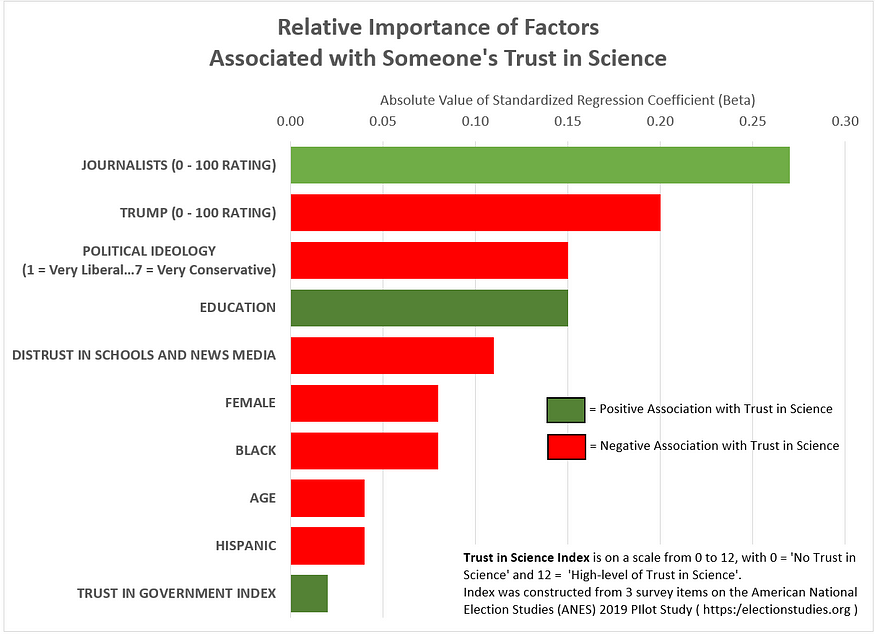
Similarly, before the lack of trust in science among some Americans is blamed on Fox News and Republicans, it must be explained why favorability towards journalists is highly related to trust in science, regardless of someone’s political ideology, support for Donald Trump, level of education, sex, or race/ethnicity.
My hypothesis is that, given the mainstream news media (including Fox News) serves such a narrow spectrum of Americans, drops in trust in journalists and, by extension, science were inevitable.
Our national news outlets represent the priorities, opinions and biases of rich, white liberals. These news sources are not objective. Worse yet, they systematically misinform anyone who digests their daily product.
And this central bias in the mainstream news media has not gone unnoticed by conservatives, particularly among the working-class who are so often a punching bag for news media elites.
One of the ugliest (and most socially destructive) arguments finding popularity in the national news media’s coverage of the COVID-19 pandemic is the suggestion that people who aren’t vaccinated should not be given the same priority for medical care as those who have vaccinated.
The once-funny, now drearily partisan Jimmy Kimmel (host of ABC’s Jimmy Kimmel Live!) exemplified this toxic kind of thinking in a recent monologue:
Kimmel opined on his show:
“The number of new cases is up more than 300 percent from a year ago. Doctor Fauci said that if hospitals get any more overcrowded they’re going to have to make some very tough choices about who gets an ICU bed. That choice doesn’t seem so tough to me — vaccinated person having a heart attack, yes, come right on in. We’ll take care of you. Unvaccinated guy who gobbled horse goo, rest in peace wheezy.”
Stories of families unable to get their sick parent or child admitted to a hospital ICU ward because those beds are filled with unvaccinated COVID-19 patients permeated the news media last fall.
Those stories are real and tragic…and, yes, I believe the unvaccinated need to understand how their health care decisions are, writ large, impacting their communities.
Yet, there is something seriously wrong if a consensus of Americans think the vaccine hesitant deserve the death penalty for their personal decision regarding vaccines. People accepting the COVID-19 deaths of thousands of Americans in “Trump” country as their ‘just desserts’ need to rethink their values.
More compassionate Americans understand that health care should never be rationed based on background or past behavior. President Barack Obama’s Affordable Care Act (ACA) is predicated on that premise.
John Barro, senior editor and columnist at Business Insider, spelled out this ACA feature on the Rising podcast last year:
“One of the key ideas behind the Affordable Care Act (ACA) — and by certain laws that led up to the Affordable Care Act, like the HIPA law — was about making sure that people with pre-existing conditions could get health insurance at the same price as people who don’t have those conditions. And the reason that we focus on having on having those rules is otherwise it can become very unaffordable for people to get health insurance if they have previously had cancer or if they have diabetes or they have other pre-existing conditions.
Our view is that health insurance is not like other insurance products. It is not like auto insurance or homeowners insurance, where, if you live on the ocean you’re going to pay more for hurricane coverage. If you have a swimming pool you’re going to pay more for liability. If you’ve got speeding tickets you pay more for auto insurance.
Health insurance laws are structured to ensure availability to as many people as possible. We have fought to de-link pricing from health risk.”
Today, too many Democrats and liberals are happy to discard the ACA’s central pricing rationale so that they can punish people they consider ‘ignorant’ and ‘deplorable.’ “Rest in peace wheezy,” sneers Kimmel.
Ironically, working-class conservatives aren’t the only ones burying themselves in ignorance regarding COVID-19. Democrats and liberals have their own intellectual blind spots on the subject matter.
The poor understanding of COVID-19’s hospitalization risk among liberals and Democrats
Coverage of the COVID-19 pandemic by the left- and center-leaning news and entertainment outlets has led to large reservoirs of misinformation residing among liberals and Democrats.
A few months ago on Jimmy Kimmel Live!, Bill Maher, host of HBO’s Real Time with Bill Maher, made a surprisingly sharp observation about the national media’s unmistakable penchant for fostering undue fear about the COVID-19 pandemic:
“I have to cite a survey that was in the New York Times, which is a liberal paper, so they weren’t looking for this answer. The question was: “What do you think the chances are that you would have to go to the hospital if you got COVID?”
The Democrats thought that (probability) was way higher than did Republicans. The answer is between one and five percent. Yet, 41 percent of Democrats thought it was over a 50 percent chance and another 28 percent thought it was between 20 and 49 percent — so 70 percent of Democrats thought it was way higher than it really was.
Liberal media has to take a little responsibility for scaring the (bleep) out of people.”
This overestimate of COVID-19’s hospitalization risk most likely keeps a large percentage of Americans submissive to a variety of ineffective policy measures meant to contain SARS-CoV-2, but which have little scientific evidence to support their implementation (e.g., broad outdoor mask mandates, closing public parks, testing vaccinated people who lack symptoms, prohibiting out-of-home-county travel by university students, and contradictory business closure measures).
Back-of-the-Envelope Estimates on “Breakthrough” Risks Associated with COVID-19
We probably know at least one family member or friend who is fully vaccinated and boosted, but who remains deeply concerned that they will still get COVID-19 from an unvaccinated person (i.e., a “breakthrough” case) and end up hospitalized or dead.
I certainly know someone who fits that profile. But is that an rational fear?
To allay this person’s anxiety, I sought out the best available U.S. data on the subject from the Centers for Disease Control and Prevention (CDC). While their aggregated “breakthrough” data only goes through November 2021 (therefore missing the impact of the Omicron variant), it is a good start for a rough estimate of the various COVID-19 risk probabilities for fully vaccinated people.
[The data I am using for this analysis is available here and here.]
Let us first estimate the chance of a fully vaccinated person getting COVID-19 over an entire year. According to the CDC, the week of August 28, 2021 saw a “breakthrough” rate of 117.74 cases per 100,000 vaccinated people in the 26 U.S. states that collect such information (the list of states can be found here). That is the highest weekly rate between April and November 2021 (the lowest being 4.96 per 100,000 during the week of June 5, 2021). To be conservative, I multiplied 117.74 by 52 weeks and divided 100,000 by that product, giving us an estimate of 1 in 16 that a fully vaccinated person will get COVID-19 over the next 12-month period.
That sounds about right. Vaccines aren’t perfect, but definitely effective. According to the CDC, an unvaccinated period has a five times greater chance on contracting COVID-19 than an vaccinated person.
What about hospitalizations? Using the same methodology, I took the CDC’s weekly hospitalization rate for fully vaccinated people (5.4 per 100,000 during the week of November 13, 2021), multiplied by 52 and divided 100,000 by that product to get this estimate: There is a 1 in 356 chance that a fully vaccinated person will be hospitalized for COVID-19 over the next 12-month period.
As a fully vaccinated person myself, I like those chances. The CDC estimates unvaccinated people have an eight times greater chance of being hospitalized for COVID-19.
Finally, the granddaddy of estimates: What are the chances a fully vaccinated person will die from COVID-19 over the next year? The CDC says, at its weekly peak between April and November last year, COVID-19 killed 1.03 vaccinated people per 100,000 vaccinated people. Multiplying that number by 52 and dividing 100,000 by that product, we get this estimate: There is a 1 in 1,867 chance that a fully vaccinated person will die from COVID-19 over the next 12-month period.
In my experience, I consider such chances basically the same as zero.
Some people, like Lloyd in Dumb and Dumber, may view probabilities differently…
But if we take that probability (1 in 1,867 each year) and extend over 60 years, we end up with a 1 in 31 chance that a fully vaccinated person will die from COVID-19 over a 60-year period. That is a 3 percent chance. Compare that to other lifetime probabilities: Dying in a car accident = 1 percent; dying of cancer = 15 percent; dying of heart disease = 17 percent.
Obviously, the lethality of COVID-19, the treatments for it, and the immunities that may build up within us to fight it off renders such a long-term estimate meaningless. But, the point remains, the chances of a vaccinated person dying from COVID-19 are exceedingly remote.
That doesn’t mean CNN won’t find those deadly “breakthrough” cases that do occur and try to scare the crap out of you.
There is irrationality on every side of the political spectrum
What is worse? Not getting vaccinated or harboring a grotesquely inaccurate understanding of the risk probabilities associated with COVID-19?
I think both pose serious problems. The unvaccinated potentially hurt themselves and those close to them who are also unvaccinated. There is also a small chance that other people will be denied ICU beds because they are occupied by unvaccinated COVID-19 patients.
But possessing an unwarranted fear of COVID-19 is equally dangerous and can also cause needless, even life-threatening, harm to others. Every time a state shuts down businesses and economic sectors due to surges in COVID-19, they are putting people out of work, a large number of whom cannot afford lapses in income and health insurance.
The wealth of the world’s wealthiest has surged during the COVID-19 pandemic, while millions of people worldwide have descended into poverty. This is not hyperbole. It is widely-accepted fact among economists. Furthermore, people can die when they become impoverished.
So, when the majority of Democrats hold irrational fears about the dangers of COVID-19, they increase the likelihood that politicians will pursue bad COVID-19 policies that may do more harm than good. People die when livelihoods are threatened and giving them a $2,000 check now and then is not enough to change that fact.
Whether from a left, right or center perspective, what is the solution to all of this? Stop watching, listening or reading the news from mainstream news outlets and seek alternative news sources (The Grayzone, Breaking Points, etc.). Perhaps then the national news outlets will consider hiring more trained journalists with backgrounds outside of our elite universities. I recommend University of Iowa journalism grads, but I’m biased.
- K.R.K.
Send comments to: kroeger98@yahoo.com
To what extent did attitudes about Biden and Trump change during the 2020 general election?
By Kent R. Kroeger (Source: NuQum.com; July 6, 2021)
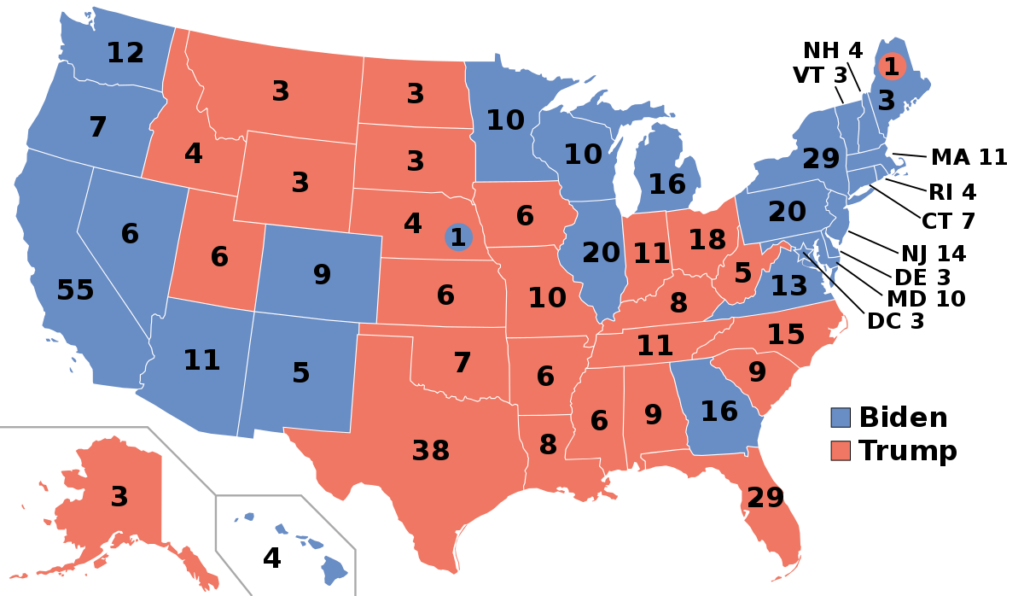
“Our political opinions and attitudes are an important part of who we are and how we construct our identities. Hence, if I ask your opinion on health care, you will not only share it with me, but you will likely resist any of my attempts to persuade you of another point of view,” New York University psychologists Philip Pärnamets and Jay Van Bavel wrote in Scientific American in 2018.
Pärnamet, Van Bavel and their associates at Lund University in Sweden had previously found that manipulating a person’s opinions and attitudes is not as difficult as sometimes thought in today’s highly partisan environment, and once changed, these new opinions and attitudes can be surprisingly durable.
In their study, after giving study participants false-feedback on one of their opinions — for example, telling a participant they had indicated their opposition to raising taxes when, in fact, they had said they supported raising taxes — the researchers offered them a chance to give an argument for their “new” opinion without fearing they would be criticized for it. It turned out that the act of rationalizing this “new” belief in a non-judgmental context made it more durable over time.
“When it comes to the actual political attitudes we hold, we are considerably more flexible than we think,” according to New York University psychologists Philip Pärnamets and Jay Van Bavel. “People have a pretty high degree of flexibility about their political views once you strip away the things that normally make them defensive.”
In other words, remove a person’s feeling of needing to defend their ideas from criticism, they are more open to alternative ideas.
Conversely, unwillingly expose someone to an opposing opinion and they are likely to erect defensive barriers to it and, in turn, become more entrenched in their original belief. [I suspect that is the reason I lose a few Facebook friends every time I post a video excerpt from Tucker Carlson Tonight.]
This is good and well, but the dominant (non-Fox News) media narrative was that, after four years of a near constant drumbeat of negative news coverage, Trump’s popularity was near an historical low-point for an incumbent president and, subsequently, the vast majority of Americans had already made up their minds about him.
Axios’ Neal Rothschild laid out the facts supporting that narrative in a Sept. 2020 article:
A wealth of evidence suggests more Americans have made up their minds by this point compared with years past:
The conventions had practically no impact on the shape of the race: Biden’s national polling lead (+7.5 per FiveThirtyEight’s average of polls) is just a half-point smaller than it was a month ago.
Just 3% of likely voters said they didn’t know who they’d vote for in a recent national Quinnipiac poll. The same percent of registered voters said they were undecided in a Monmouth poll this week.
An August poll by the Pew Research Center found that among those who preferred Biden or Trump, just 5% said there was a chance they’d change their minds.
Compare that to Pew’s poll in August 2016, which found that 8% of Hillary Clinton’s supporters said there was a chance they might vote for Trump. Similarly, for those who preferred Trump, 8% said they might vote for Clinton.
Even in the swingiest of swing states, most people’s minds appear made up. Just 5% of Floridians say they might change their minds, according to a recent Quinnipiac poll.
Political scientists happily concurred with the ‘set in stone’ narrative heading into the 2020 general election. “There were Republicans who were undecided in 2016 but ultimately rallied to Trump,” John Sides, a political science professor at Vanderbilt, told Axios. “This year, they’re likely on board. And, if not, they jumped ship a while back.”
Rothschild and Sides were justified in their conclusions, but still wrong in the bigger picture.
To what extent did attitudes about the 2020 presidential candidates change?
Data from the 2020 American National Election Study (ANES), conducted in two waves (pre- and post-election) between August and December 2020, confirm significant numbers of vote eligible Americans changed their opinions about the two major presidential candidates during the course of the general election.
Enough that it could have changed the final outcome? Probably not. Nonetheless, it is inaccurate to suggest, even in today’s highly partisan political environment, that attitudes about Biden or Trump were largely ‘set in stone’ before Election Day.
For starters, one-third of eligible voters changed their favorability rating of Trump by at least 10-points (on a 100-point scale) during the course of the general election. [The text of the ANES 2020 thermometer favorability questions are in the Appendix A.]
Among Strong Republicans, 24 percent of respondents became less favorable towards Trump during the campaign. That translates to 11.5 million Strong Republicans — three million of whom either voted for Biden (660,000) or did not vote (2.3 million!). These are potentially election outcome changing numbers, especially when an outcome change in just four closely contested states would have changed the Electoral College outcome.
Tables 1a and 1b (below) show the percentage of vote eligible Americans that changed their favorability rating by at least 10-points for Joe Biden and Trump between the general election and the post-election period.
For example, among Strong Democrats, 14 percent of ANES 2020 voters reported lower favorability ratings for Biden between the general election and post-election period, while 26 percent increased their favorability rating for him. Sixty percent reported no change in their favorability rating of Biden. Weak (‘Not Strong’) Democrats and Independents leaning-Democrat were similarly inclined to upgrade Biden.
More importantly, the percentage of Independents who upgraded Biden was significantly higher than those who downgraded him (32% versus 21%).
Among Republicans, no significant difference existed between the percentage of those who upgraded or downgraded Biden between the pre- and post-election periods.
Overall, 44 percent of eligible voters changed their favorability rating of Biden between the pre- and post-election ANES 2020 surveys.
Table 1a. Biden Favorability Change (Pre- to Post-Election)

Table 1b. Trump Favorability Change (Pre- to Post-Election)

The pattern for Trump was quite different.
Across all party identification groups — with the exception of Weak (‘Not Strong’) Republicans and Weak (‘Not Strong’) Democrats — all partisan groups experienced a higher percentage of respondents who downgraded Trump versus those who upgraded him. For example, among Independents, 28 percent lowered their favorability towards Trump, while only 19 percent increased it.
Overall, 66 percent of eligible voters did not change their view about Trump over the course of the 2020 presidential campaign, compared to only 56 percent for Biden.
For many possible reasons, Biden plainly increased his favorability advantage over Trump during the 2020 general election (see Table 2a) and this advantage was significantly correlated with final vote choices (see Table 2b).
Table 2a. Mean Levels and Mean Changes in Candidate Favorability (100-point scale)

Table 2b. Correlation between Favorability Rating Gaps and 2020 Vote Choice
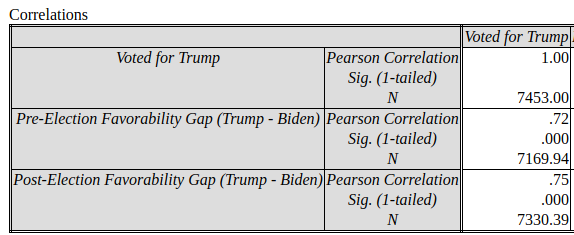
Even after controlling for key demographic characteristics (age, education, income, race, sex), party identification, political ideology, and policy attitudes (abortion, health care, job guarantee, social spending, defense spending, and environment), the favorability gap between Trump and Biden was the strongest predictor of vote choice (see in Appendix B a preliminary logistic model of the 2020 presidential vote choice).
Trump failed to tarnish Biden
A methodological note is required before moving forward…
The ANES 2020 post-election favorability question was asked after the actual election. Subsequently, how a respondent answered that question was potentially impacted by the outcome of the election. It is, therefore, dubious to draw any conclusion about the impact of a change in candidate favorability on how people voted. Our predictor variable (change in favorability ratings) is contaminated by the outcome variable (vote choice).
Nonetheless, the relationship between those two variables is informative. Tables 3a and 3b show the relationship between changes in the Biden and Trump thermometer ratings and 2020 vote choices.
In Table 3a, among the largest thermometer change group (No Change Towards Biden), 44 percent voted for Biden, compared to only 32 percent for Trump. Conversely, among those who indicated no change in favorability towards Trump, 30 percent voted for Trump, compared to 48 percent who voted for Biden (see Table 3b).
Table 3a. Biden Favorability Change (Pre- to Post-Election) by 2020 Vote Choice
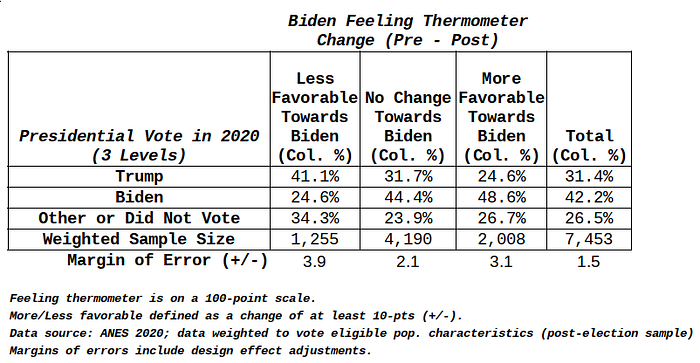
Table 3b. TrumpFavorability Change (Pre- to Post-Election) by 2020 Vote Choice
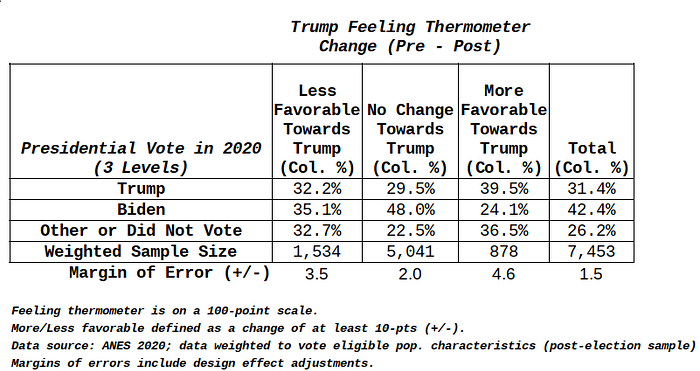
The status quo was in Biden’s favor. But what about among voters who increased their rating of Biden between the pre- and post-election periods?
Forty-nine percent of respondents who increased their rating for Biden also voted for him, compared to only 25 percent who voted for Trump — that is a 24-point gap (see Table 3a).
In contrast, 40 percent of respondents who increased their rating for Trump also voted for him, compared to 24 percent who voted for Biden — that is a 16-point gap (see Table 3b). In that same group, 37 percent did not vote for president — the highest non-voting rate among the thermometer rating change groups.
Among respondents who lowered their view of Trump during the general election, there was no significant vote share difference between Trump and Biden (32% versus 35%, respectively). Put differently, beating Trump down did not change many votes. Instead, Biden’s victory was built on the back of a status quo environment already in his favor (e.g., the COVID-19 pandemic, a weakened economy) and a general election campaign that generated additional positive feelings towards him.
The Trump campaign and Republican Party failed to convince the American voting public to dislike Biden, and it wasn’t for a lack of trying.
It is hard to see the resiliency of Biden’s popularity and not think the news media played a critical role. In a previous essay, I detailed the overwhelming advantage in tone Biden had over Trump in online news coverage during the 2020 election.
But were there any particular TV news programs disproportionately associated with Americans who changed their opinions of Biden and Trump during the campaign? Fortunately, the ANES 2020 asked respondents which TV news programs they watched regularly (question text is in Appendix A) and offers at least a preliminary look at that question.
Did some news shows matter more than others in 2020?
Quantifying media effects in political campaigns has been one of the holy grail quests of political scientists for decades. And, typically, when positive results have been found, the research has required tightly-controlled experimental designs and idealized research settings. The challenge in finding consistent, strong media effects in political campaigns is partly the result of two real-world challenges.
First, there is a mammoth selection bias problem. People do not choose their media sources randomly. The factors that drive their selection of news shows also drive their preferences for political candidates. Furthermore, we don’t have a Walter Cronkite who can suddenly voice disillusionment with the Vietnam War and bring millions of Americans along with him. Anything Rachel Maddow says on her show, her audience is most likely already with her.
Second, virtually every potential voter consumes information derived from the news media. Voters are awash in news and information. Trying to determine if a voter’s opinions are affected by the news media is akin to wondering if a fish likes water.
Despite the methodological hurdles, the ANES 2020 data does show some interesting (while admittedly small) associations in TV news program preferences and changes in 2020 candidate favorability ratings. And while these associations don’t hold up when controlling for other factors (demographics, party id, policy attitudes, etc.), the bivariate relationships show some intriguing patterns.
Table 4 shows the relationship between a change in Biden or Trump favorability and TV news programs regularly viewed. Only statistically significant associations (chi-square statistic) are indicated, either by a (+) indicating a positive association, or a (-) indicating a negative association.
For example, regular viewers of Stephen Colbert’s Late Night were more likely to have their favorability towards Trump go unchanged during the campaign, and less likely to have become more favorable towards Trump. The net effect of Late Night’s continual bashing of Trump seemed to be in enforcing status quo opinion.
Table 4. Change in Biden/Trump Favorability by Regular Viewers of Selected News Programs (Pre- versus Post-Election)

For every news programs demonstrating significant associations with Biden or Trump favorability, the association was positively related to “no opinion change.” In fact, the only positive relationship with a change in candidate favorability was between people who became more favorable towards Trump and do not watch TV news programs regularly (see bottom-right corner of Table 4).
My interpretation: To the extent individual TV news programs matter at all in elections, it is in attracting viewers who are already less inclined to change their opinions about candidates. TV news programs enforce partisan alignments and are not independent, unbiased sources for news and information.
Final Thoughts
If ever there was going to be an election where the outcome was ‘set in stone’ long before Election Day, it would have been the 2020 presidential election.
In reality, there was significant opinion change among eligible voters towards Biden and Trump in the 2020 general election, despite a relentless effort by the mainstream news media to dampen such behavior.
Research by Swedish psychologists Pärnamets and Van Bavel mentioned at the beginning of this essay has been focused on changes in policy attitudes, not candidate support, but their conclusions concerning the former are likely relevant to the latter:
“…we need rethink what it means to hold an attitude. If we become aware that our political attitudes are not set in stone, it might become easier for us to seek out information that might change them.
There is no quick fix to the current polarization and inter-party conflict tearing apart this country and many others. But understanding and embracing the fluid nature of our beliefs, might reduce the temptation to grandstand about our political opinions. Instead humility might again find a place in our political lives.”
Amen.
- K.R.K.
Send comments to: kroeger98@yahoo.com
Appendix A:
Key Questions from ANES 2020
Pre-election Favorability Question:
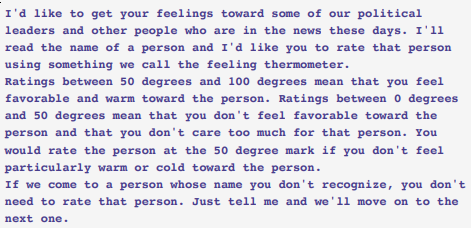
Post-election Favorability Question:
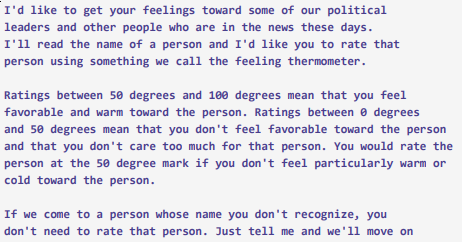
TV Show Viewing Question:

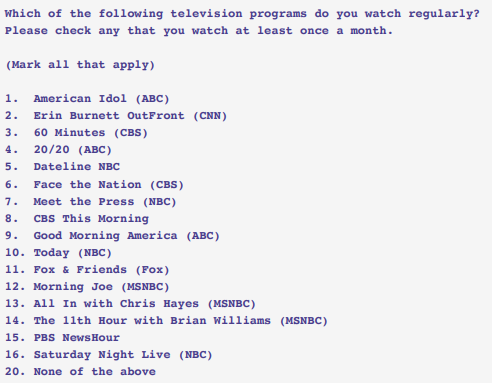
Appendix B:
Preliminary Logistic Model of 2020 Vote Choice
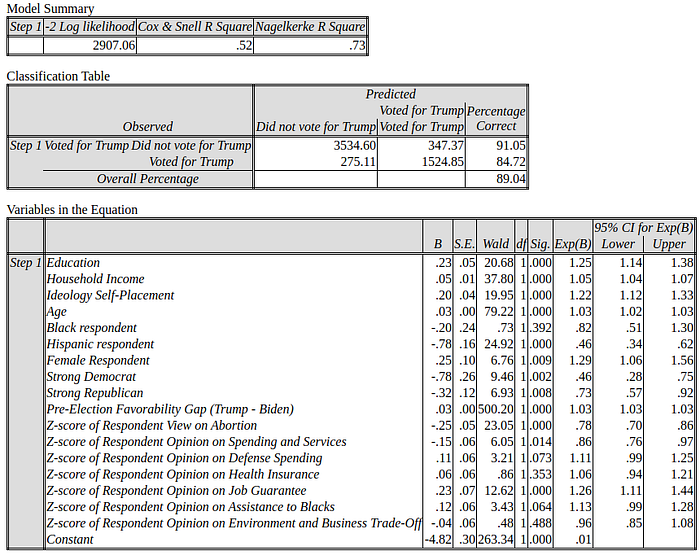
The news media too often serve up elite opinion instead of reality
By Kent R. Kroeger (Source: NuQum.com, June 25, 2021)

In his classic 1984 Duke Law Journal essay, The Marketplace of Ideas: A Legitimizing Myth, Law Professor Stanley Ingber described the news and information landscape within the U.S. in ways easily applied to today:
“In our complex society, affected by both sophisticated communication technology and unequal allocations of resources and skills, the marketplace’s inevitable bias supports entrenched power structures or ideologies. Most reform proposals do little to help the marketplace reach its theoretical potential. Instead, such suggestions perpetuate the marketplace’s status quo bias or result in unacceptable levels of governmental interference and regulation.” (p. 85–86)
But Ingber’s view of our information ecosystem doesn’t require a conspiracy among economic and political elites to explain its biased effects:
“…the New Left presumed that this effect resulted from a conspiracy of established groups. Their view of the system as a construct of devious, manipulating elites seems overly simplistic. The elites need not consciously create and impose a system in order to benefit from it. The bias or skew toward established groups and dominant value perspectives instead may be unavoidable in a high-technology society in which resources and skills are distributed unequally.” (p. 85)
To Ingber, inequities in what facts, ideas and opinions most prominently make it into the information bloodstream stem from systemic inequities, not the coordinated actions of a small cadre of elites — which is why he dismisses popular freedom of speech reforms, such as The Fairness Doctrine and federal election campaign laws, that he said “easily could decay into formal systems of governmental censorship or popular indoctrination.”
“If we intend to design a social and political system open to the development of diverse perspectives and values, we must first understand how an idea initially outside the community agenda of alternatives becomes accepted within it.” (p. 86)
While Ingber rejects leftist assumptions that the system is the product of “devious, manipulating elites,” he may have been equally naive in believing powerful interests don’t have a demonstrable, independent impact on existing imbalances on what information gets promulgated within the mainstream news media. Nonetheless, Ingber’s analysis from 40 years ago remains brutally relevant to today.
Ingber argued some legitimate perspectives, outside mainstream thought, are denied access to a sizable audience because of structural barriers within the system.
In rare instances, such as when ecological realities profoundly change — like in the Great Depression or the Vietnam War — do novel perspectives become integrated into the mainstream discourse, according to Ingber. “There is little doubt that a change in the ecological setting necessarily creates new interests and needs which in turn alter perspectives,” he wrote.
So we must wait until the next great economic recession or counterproductive U.S. military intervention to see substantive changes in status quo thinking? Ingber offers another path:
“In addition to ecological change, new perspectives and values may be nurtured in a society that encourages, or at least permits, the development of new interests and experiences. Consequently, the status quo bias of the marketplace can probably be neutralized only by protecting a greater liberty of action — allowing people to choose among lifestyles offering differing roles and relationships — rather than merely supporting the freedom of speech.”
Homogeneous sourcing: A case study using a New York Times story on ISIS in Africa.
At the heart of the Ingber argument is that a diversity of perspectives is critical to minimizing the ‘status quo bias’ of the marketplace of ideas: An informed, free-thinking society, empowered by experiential diversity, is capable of navigating contradictory ideas (including falsehoods) when given the necessary information needed to weigh them against one another.
Ingber’s 1984 essay came to my mind recently as I waded through hundreds of news articles about the alleged growing strength of jihadists on the African continent — articles like the following:
ISIS attacks surge in Africa even as Trump boasts of a ‘100-percent’ defeated caliphate (Washington Post, October 18, 2020)
Is Africa overtaking the Middle East as the new jihadist battleground? (BBC, December 3, 2020)
In bid to boost its profile, ISIS turns to Africa’s militants (New York Times, April 7, 2021)
With few exceptions, these articles and many others like them rely heavily on official government sources and U.S./European-centric think tank analysts, who, by training and financial support, back a common thesis: Islamic extremists are turning to Africa to continue and expand their war against Western institutions and influence.
Keep in mind, we are talking about a continent with over 1.2 billion people (of whom 44 percent are Muslim), and more racial/ethnic/genetic diversity than any other continent on the planet. Almost any hypothesis regarding Islam can find anecdotal support somewhere within its vast geography.
On one hand, Islamic jihadists are on the rise (Ansar Dine in Mali) ; and, on the other, Islam and democracy are not antithetical (Tunisia).
Africa and Islam are too complex to summarize in pithy headlines.
And, yet, that is exactly what our most prestigious news organizations do every day, and they do so while generally depending on a relatively narrow range of sources and perspectives.
As anecdotal evidence, we have the April 7th New York Times article, by Christina Goldbaum and Eric Schmitt, which included these sources:
(1) The Soufan Group — a New York-based security consulting firm founded by an ex-FBI interrogator— Ali Soufan — and highly regarded within the U.S. national security establishment,
(2) Africa Center for Strategic Studies — a U.S. Department of Defense (DoD) research institute,
(3) Global Coalition to Defeat ISIS — a U.S. State Department-organized coalition of 80 nations opposed to ISIS,
(4) ExTrac — a private, data-driven intelligence service (based in the U.S.) which combines “real-time attack and communications data with artificial intelligence (AI) to provide actionable insights for counterterrorism and Common Vulnerabilities and Exposures (CVE) policymakers and practitioners,”
(5) The International Crisis Group — a non-profit, non-governmental organization used by policymakers and academics “working to prevent wars and shape policies that will build a more peaceful world,” though described by journalist Tom Hazeldine as a group that “consistently championed NATO’s wars to fulsome transatlantic praise,”
(6) Mozambican Research Institute (Observatory of Rural Areas) — a Mozambican non-governmental organization that aims to contribute to the sustainable development of Mozambique’s rural regions,
(7) “Experts and officials in the U.S. and Europe,”
(8) “American and United Nations counterterrorism officials.”
These aren’t necessarily disreputable or dishonest sources for knowledge about Islamic State (IS)-related militant activities in Africa, but they are demonstrably linked to the U.S.-European security and foreign policy establishment — with the exception of the Mozambican Research Institute, which was one of the few sources in the Times article saying Islamic State jihadists are not well-liked among rural Mozambicans.
Most of the Times’ sources represent a bounded range of viewpoints on the strength of Islamic militants in Mozambique and the continent overall. To the Times’ credit, alternative viewpoints were elicited in their story — the problem is that it took until the 30th paragraph in a 36-paragraph story to hear them:
“People in Cabo Delgado (Mozambique) have come to realize this group is not a solution, it’s destroying the local economy and it’s become very, very violent with the population,” said João Feijó, a researcher at the Mozambican Observatory of Rural Areas. “Nowadays the group is pretty isolated.”
That represents status quo journalism in a nutshell: Rely almost entirely on establishment sources and declare the story balanced because an alternative opinion was cited somewhere near the end of the story.
It is not a conspiracy — it is merely the result of journalists taking the path of least resistance by emphasizing expediency and ‘what is publishable’ over healthy intellectual curiosity.
What should international affairs journalists be doing instead? My answer would be something told to me in my first journalism class by the late Hanno Hardt, Professor Emeritus in the University of Iowa’s School of Journalism and Mass Communication:
Seek as many points of view as necessary to tell the whole story.
The Times story on the Islamic State in Mozambique or the other ‘rise of IS in Africa’ articles, all offer one dominant perspective — that of the U.S.-European defense and security community.
However, scratch the surface of this narrative — Islamic extremism is rising in Africa and the U.S. and Europe must somehow intervene — and the story becomes more complicated and less open to easy solutions.
We can start by looking at overall trends…
A little data sheds a lot of light on African violence
Figure 1 shows the number of disorder events occurring in Africa since 1997, according to The Armed Conflict Location & Event Data Project (ACLED), a widely used real-time data and analysis source on political violence and protest around the world.
The topline finding is that violence is on the rise in Africa and it is happening in more than Muslim-majority or near-majority countries — it is happening throughout the continent.
Figure 1: Disorder events in African countries since 1997
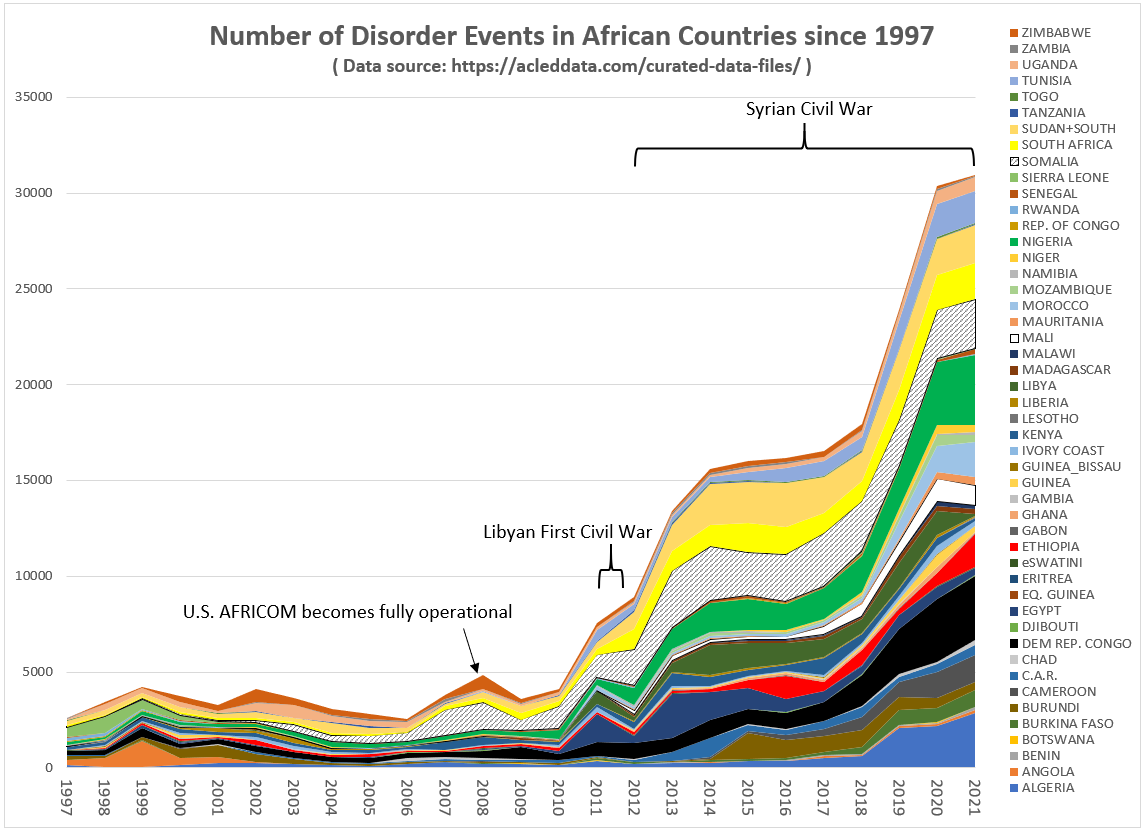
Not as easily discernible in the above time-series graph, however, is what may be causing this surge in violence.
Here are some initial thoughts…
There is academic research and strong anecdotal evidence that the aftermath of the Libyan and Syrian civil wars played a significant role in the timing and spread of this violence in Africa.
One of the first and largest year-to-year increases in African violence (i.e., disorder events) occurred from 2010 to 2011, which coincides with a series of key events in north Africa and the Middle East: (1)The Arab Spring, beginning with protests in Tunisia on December 18, 2010 in Sidi Bouzid, (2) the practical end of the U.S. occupation of Iraq, (3) the start and end of the First Libyan Civil War, and (4) the start of the (still on-going) Syrian Civil War.
The significant year-to-year rise in African violence continues until it tapers off in 2015 and remains relatively constant through 2017, when it starts to dramatically increase again in 2018 — the year after Bashar al-Assad’s government forces in Syria, with the help of Russia and Iran, finally gained the upper hand against the Islamic State (ISIS) and other jihadist forces, leading to a reduction in violence across most of the country, and prompting some jihadists to leave Syria to go home or join other conflicts (e.g., Afghanistan).
Through the first five months of 2021, five African countries — Nigeria, Dem. Rep. of Congo (DRC), Algeria, Somalia, and South Africa — account for nearly half (46%) of all disruptive events on the continent, according to ACLED, of which two are predominately Christian countries (DRC and South Africa).
It does not minimize the present threat of Islamic extremists in Africa (which is real) to acknowledge that a significant amount of the current violence is not related to Islam. And where Islamic extremism is the issue, it is fair to recognize that Western powers played a crucial role in events leading up to Islamic extremism’s rise in Africa.
The Arab Spring in Africa’s Maghreb and the First Libyan Civil War
A common conclusion among Western analysts about rising African violence is that it is partially a byproduct of ISIS’ defeat in Syria, 2011’s Arab Spring, and the return home of foreign fighters from Libya’s First Civil War.
Let us start with the first point…
To what extent did ISIS fighters in Syria end up in Africa? An exact number is impossible to determine — and there was reporting suggesting it was smaller than anticipated — but there were notable Islamic extremist attacks in northern Africa in 2018 and 2019, including a December 26, 2018 bombing of Libya’s foreign ministry, and a January 17, 2019 raid in northeastern Nigeria. And, more recently, an horrific jihadist attack killing 130 people in Burkina Faso further highlights the presence of jihadist ideology in northern Africa.
The ACLED data on African violence in Figure 1 is also illuminating on how the 2011 Arab Spring, along withthe end of the First Libyan Civil War in that same year, may have impacted subsequent violence in Africa’s Sahel region.
According to the ACLED data, in 2011, the Arab Spring saw the number of disorder events increase exponentially in Muslim-majority countries of Algeria (+187%), Libya (+13,220%), Morocco (+1,300%), and Tunisia (+1,964%).
However, the real story may be how violence spread into Africa’s Sahel after the fall of Col. Muammar al-Gaddafi’s Libyan regime in October 2011, when foreign fighters, who had been supporting Gaddafi’s government forces, joined other militant movements or returned to their home countries, well-armed, relatively well-trained and unemployed.
In 2012, of the 12 nations making up the Sahel, nine saw a significant increase in disorder events: Central African Repubic (+90%), Chad (+33%), Ethiopia (+94%), Mali (+923%), Mauritania (+143%), (Nigeria (+161%), Senegal (+83%), South Sudan (+291%), and Sudan (+120%). The three Sahel countries that didn’t see significant rises in violence in 2012 (Burkina Faso, Eritrea, and Niger) did experience increases in 2011 (Burkina Faso and Eritrea) or in 2013 (Niger).
But while most of the Sahel violence has occurred in Muslim-majority countries and many of the rebel groups involved, such as Mali’s militant Islamist sect Ansar Dine, are ideologically linked to al-Qaeda or ISIS, it would be a mistake to assume this rise in violence is only rooted in an Islam versus the Secular World paradigm. In fact, among the 19 African countries with the largest Christian majorities (70 percent+) and Muslims representing less than 20 percent of the population, 13 witnessed significant increases in disorder events in 2011 and 2012 (Angola, Botswana, Democratic Republic of Congo, eSwatini, Gabon, Ghana, Kenya, Lesotho, Liberia, Namibia, South Africa, Zambia and Zimbabwe).
Along with Islamic State and al-Qaeda aligned militant groups, Africa has a significant number of non-Islamic rebel movements: the Lord’s Resistance Army in Sudan and South Sudan, The Cabinda State Liberation Front (FLEC) in Angola, the Coalition of Patriots for Change in the Central African Republic, and the National Movement for the Liberation of Azawad (NMLA) in Mali, to name just a few. The NMLA is particularly interesting in that its manpower and firepower increased substantially after the fall of Gaddafi’s Libya and the return to Mali of ethnic Taureg’s who had fought in that conflict.
Violence is rising throughout Africa. That is a fact. As to its sources, any causal model depending solely on the proximate role of Islamic jihadists fails to consider other important factors. Furthermore, it is somewhat laughable to presume there is a “model” that can reliably explain violence (disruptive events) for an entire continent of 1.2 billion people.
Nonetheless, the exercise in trying to build such a model is worthwhile, even if a bit futile in the end.
Possible factors in the rise of violence in Africa
ISIS and other Islamic extremist groups: ISIS is no doubt part of Africa’s violent mix, particularly in northern Africa. But is this marginally cohesive organization really the threat to stability on the African continent, an extraordinarily big place with more linguistic, religious and genetic diversity than any other continent in the world? Considering Sunni jihadist groups have, in the past, been highly dependent on financial support from countries like Saudi Arabia and Qatar, is it perhaps short-sighted to focus on a symptom (such as the Islamic State) rather than a root cause (the Saudi funding and promotion of Sunni Wahhabism)?
U.S. and European interventions: It is also defensible to recognize the role U.S.-European interference in creating African instability. Academics and analysts have documented the contribution of Libya’s post-Gaddafi instability to the weaponizing of rebel groups in northern Africa and subsequent rises in violence. Once one of the wealthiest African nations prior to NATO’s coordinated military effort to destabilize Gaddafi’s government, the Libyan economy was shattered after his fall (see Figure 2 below where the top line tracks Libya’s GDP per capita since 1999), which had a direct impact on Libya’s poorer neighbors whose economies partially depended on monetary influxes from Libya.
Figure 2: GDP per capita for Libya and selected north African countries over time
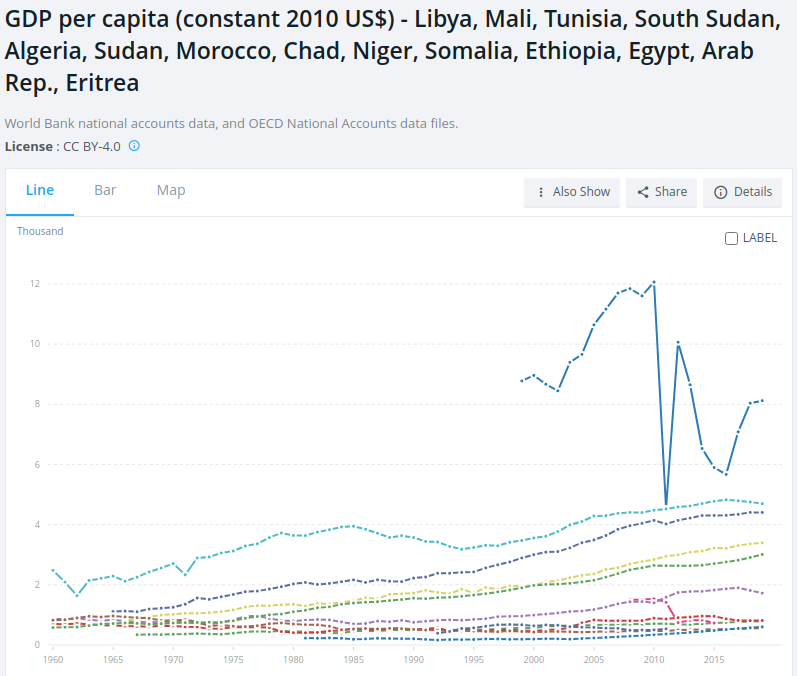
In addition, French military operations in Mali since 2013 (such as Operation Serval and Operation Barkhane) have not stopped Islamic jihadists from gaining control of much of northern Mali and a growing resistance from the Mali populace to the French military presence in general.
Any argument supporting U.S.-European interventions in Africa must contend with the reality that such interventions have a checkered record in terms of bringing stability — and that is probably too generous an assessment.
Falling oil prices and economic stagnation: The first 15 years of the 21st-century witnessed an historic economic boom in sub-Saharan Africa, with GDP per capita rising over 42 percent (see Figure 3). At the same time, a relative surge in oil prices also contributed to economic prosperity in oil-producing countries like Libya and Nigeria (see Figure 4).
Figure 3: GDP per capita in Sub-Saharan Africa since 1960
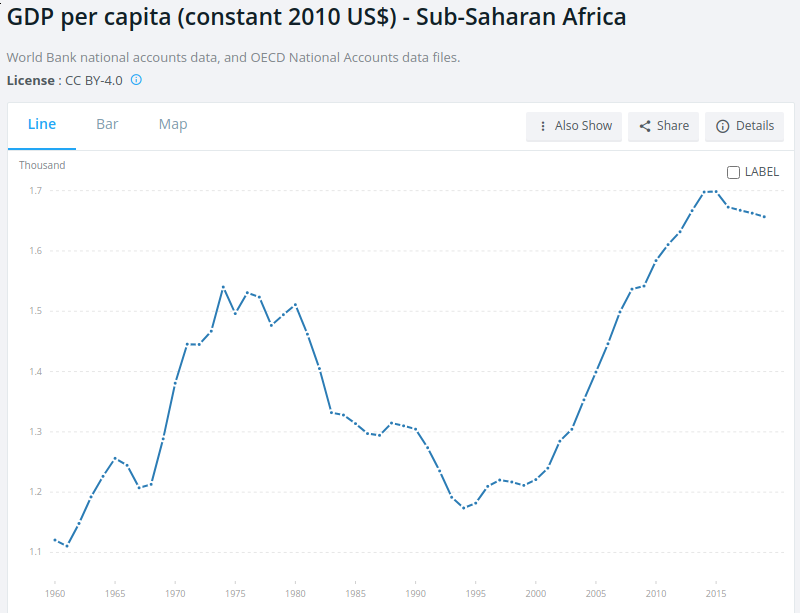
Figure 4: Oil rents (as a % of GDP) since 1970
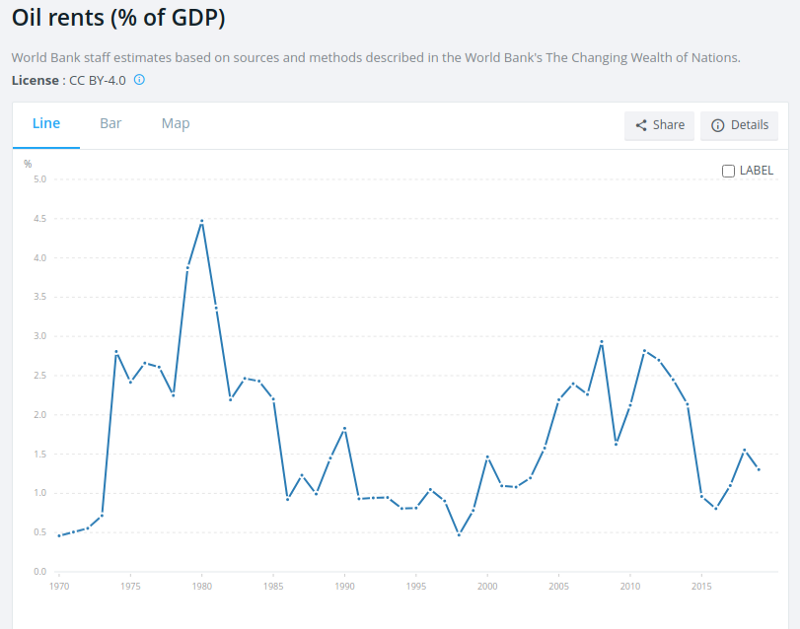
Unfortunately, the African economies stagnated after 2011, in part due to falling commodity prices and, more generally, the weakened world economy that followed the 2008 world financial crisis.
Quantitative research on political violence and insurgencies has consistently found economic deprivation plays a significant role in the ability of militant groups to recruit soldiers and popularize their movement within a population, particularly when in the midst of local and regional economic inequities and weak political institutions.
In their influential research paper, Ethnicity, Insurgency, and Civil War, Stanford political scientists James D. Fearon and David D. Laitin, who analyzed 161 countries between 1945 and 1999, concluded that:
The factors that explain which countries have been at risk for civil war are not their ethnic or religious characteristics but rather the conditions that favor insurgency. These include poverty-which marks financially and bureaucratically weak states and also favors rebel recruitment-political instability, rough terrain, and large populations.
More recent cross-national research, focused on Sub-Saharan African countries between 1986 and 2004, concluded that the onset of civil conflict is more likely in regions with (1) low-levels of education, (2) strong relative economic deprivation, (3) strong intraregional inequalities, and (4) the combined presence of natural resources and relative deprivation.
Even 2013 research on Boko Haram, a Nigerian Islamist group, by the quasi-governmental U.S. Institute of Peace concluded that: “Poverty, unemployment, illiteracy, and weak family structures make or contribute to making young men vulnerable to radicalization. Itinerant preachers capitalize on the situation by preaching an extreme version of religious teachings and conveying a narrative of the government as weak and corrupt. Armed groups such as Boko Haram can then recruit and train youth for activities ranging from errand running to suicide bombings.”
Striking throughout the quantitative literature on civil wars and regional insurgencies is the lack of significance among ethnic and religious variables in explaining the outbreak of violence.
Contrary to the security establishment sources in the Times article who argue that U.S.-European military support is essential to stemming the rise of militant Islam in Africa, a broader, more objective canvass of sources would have found as many experts arguing the most effective approach to ending the violence would be for increased investments in education, infrastructure, poverty alleviation and good governance initiatives by African governments.
Both arguments can be true, of course. But one would never know that such a contrast in solutions existed if all one had was the New York Times to rely on.
Final Thoughts
In previous posts I’ve lamented the many blind spots that seem to define mainstream journalism today. More disturbing (to me) is the propensity of the national news media to uncritically repeat the opinions of the U.S. national security industry.
If you want to understand why elite media organizations like the New York Times or Washington Post can get so many stories wrong, just look at the sources they continuously canvass for quotes (not to mention their documented willingness to use other journalists as “independent” sources).
How is it possible that the most prestigious, best paid journalists in the U.S. get so many stories utterly wrong?
Nowhere is this problem more apparent than news coverage of international affairs when news organizations incestuously recirculate the same quotes from the monolithic U.S.-European think tank brigade — an insular cadre of career policy analysts and former defense and intelligence officials from places like the Council on Foreign Relations, Human Rights Watch, The Brookings Institute, American Enterprise Institute, Center for American Progress and the Center for Strategic and International Studies — or when they lazily depend on anonymous “intelligence sources” and nameless government officials.
The last place to go for an objective analysis of African defense and security issues are these aforementioned sources. Yet, that is the source of most all mainstream reporting on the topic.
- K.R.K.
Send comments to: kroeger98@yahoo.com
The inconvenient truth about prejudice and racism in the U.S.
By Kent R. Kroeger (Source: NuQum.com; May 10, 2021
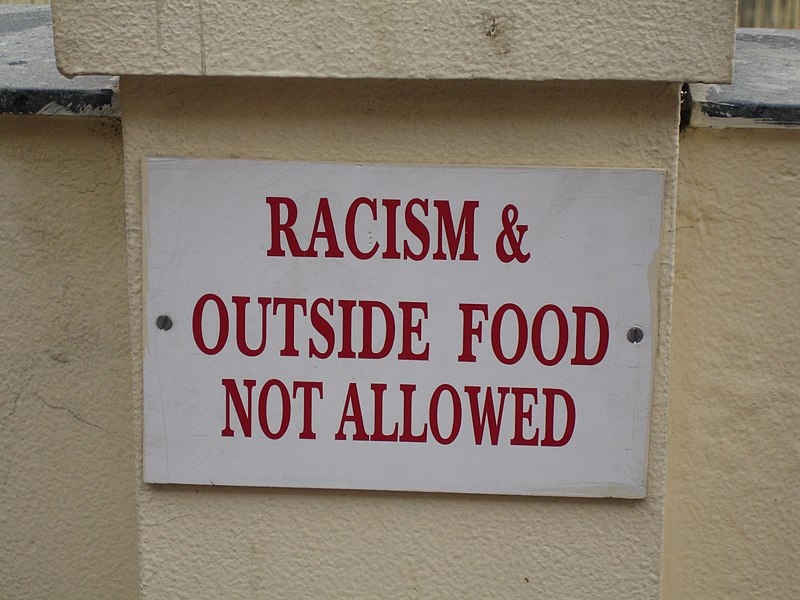
“If you can’t measure it, you can’t improve it.” — Peter Drucker
“One can ignore reality, but one cannot ignore the consequences of ignoring reality.”— Ayn Rand
Since my days as a young grad assistant in the late 1980s, I have periodically worked in and around the social science debate on the best methods for measuring racist attitudes and behaviors in the U.S.
With respect to racial attitudes, in particular, I have encountered two main schools of thought. The first school believes we can ask people directly about their feelings on race and ethnicity and receive substantively unbiased answers (in the statistical sense of bias). While people are capable of hiding their true feelings on sensitive subjects (i.e., the social desirability bias), if the research study is well-designed and protects anonymity, people will answer questions on socially sensitive issues with surprising honesty, according to this school of thought.
The second school is not as sanguine. In their view, people are captive to their desire to leave a favorable impression with others and will try to avoid being classified as a ‘racist’ or ‘bigot.’ Thus, people will modify their responses on opinion surveys regarding racial attitudes to avoid such pejorative labels. In other words, researchers can’t simply ask people what they think on race, but must employ indirect methods for assessing an individual’s true racial attitudes (such as randomized response techniques).
While I am sensitive to the concerns of the second school, in practice I have found simple, direct questions on race and ethnicity to consistently reveal substantive differences in racial attitudes among U.S. adults. [An excellent research summary on these two school of thoughts can be found here. I also covered this research controversy in a previous Medium.com essay.]
With this caveat in mind, here are results from one of the latest research studies on U.S. attitudes regarding race and ethnicity, collected by researchers from Stanford University and the University of Michigan in the 2020 American National Election Study (ANES).
Racist attitudes are not just a Republican problem
The 2020 ANES administered a series of thermometer scales (0 to 100) to assess respondents’ favorability towards four specific race and ethnic groups (Whites, Blacks, Hispanics and Asians):
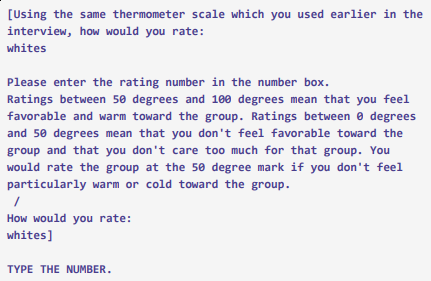
How does someone answer a question like this if they consciously refuse to judge anyone based on their race or ethnicity? As it turns out, about 15 percent of all respondents (out of 7,453 respondents to the post-election wave of the 2020 ANES) rated the four racial and ethnic groups as a ‘50.’ Some other respondents rated the four groups as equal at a different point on the scale. For example, nine percent of respondents rated all four groups a ‘100’. [Eight people rated each of the four race and ethnic groups a ‘0’!]
In total, 51 percent of U.S. eligible voters rated their own race/ethnicity as equal (or below) the other three race and ethnic groups (I label these respondents as “Racial Neutralists”). Another 34 percent of eligible voters rate their race or ethnic group higher than at least one other race or ethnic group (I label them “Racial Chauvinists”).
Lastly, an additional 16 percent of respondents either refused to answer the race/ethnicity favorability question for their own race/ethnic group or were from a race/ethnic group (e.g., Native American and multi-race respondents) where favorability ratings for their group were not asked (I label these respondents as “Unclassifiable”).
The number that seems to shock those I’ve shared this data with is the 34 percent of U.S. eligible voters who openly admit they harbor some level of racial or ethnic bias.
My wife’s initial reaction was to say, “They must be Trump Republicans.” — a reaction that was not unique. After analyzing 100 30-second news clips broadcast on CNN and MSNBC between May 1, 2020 and May 1, 2021 (the GDELT-archived clips can be found here), every single one explicitly connected racism to either Donald Trump supporters, conservatives, Republicans or white supremacists within those groups.
Is racism, in fact, mostly a Republican or white conservative problem?
Well, it depends on how you define mostly.
As Figure 1 shows, the percentage of racial chauvinists isbasically identical within the Biden and Trump voter bases (33.1 percent and 33.6 percent, respectively). Likewise, slightly over half of Biden and Trump voters can be categorized as racial neutralists. In contrast, third party voters are significantly less likely to be racial chauvinists (21.6 percent).
Figure 1: Racial/ethnic bias within the 2020 U.S. electorate (by presidential candidate)

How can that be true? Did the Trump voters lie on the ANES survey?
Relax my resistance friends. The news isn’t entirely positive for Trump Republicans.
If we examine the 2020 electorate by their race/ethnicity, a more familiar picture of racial bias emerges. Figure 2 indicates that 29.1 percent of Trump voters are white racial chauvinists (i.e., rated Blacks, Hispanics, and/or Asians below Whites on a 100-pt. favorability scale), compared to only 10.5 percent of Biden voters. In other words, Trump voters are three times more likely than Biden voters to be white and a racial chauvinist.
At the same time, Biden and Trump voters are equally likely to be white and a racial neutralist (42.0 percent and 47.5 percent, respectively). That is to say, if you were to randomly draw one Trump voter and one Biden voter from their respective populations, you would have an equal chance in each case of drawing a white person with no (self-reported) racial bias.
Figure 2: Racial/ethnic bias within the 2020 U.S. electorate (by presidential candidate and eligible voter’s race/ethnicity)
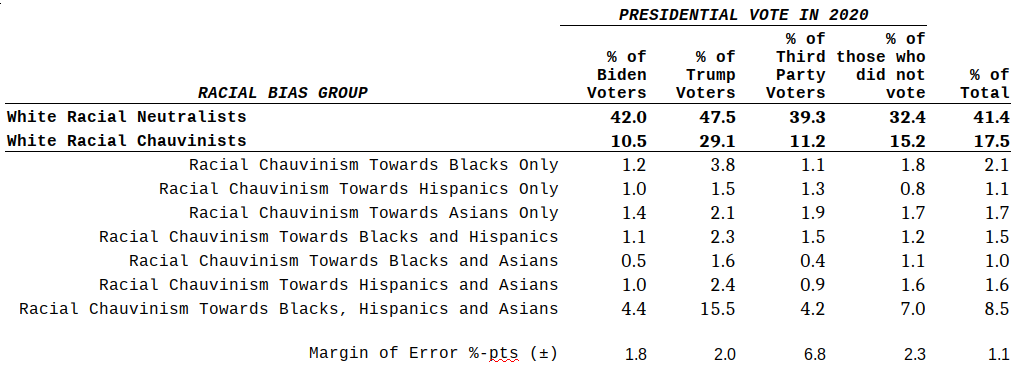
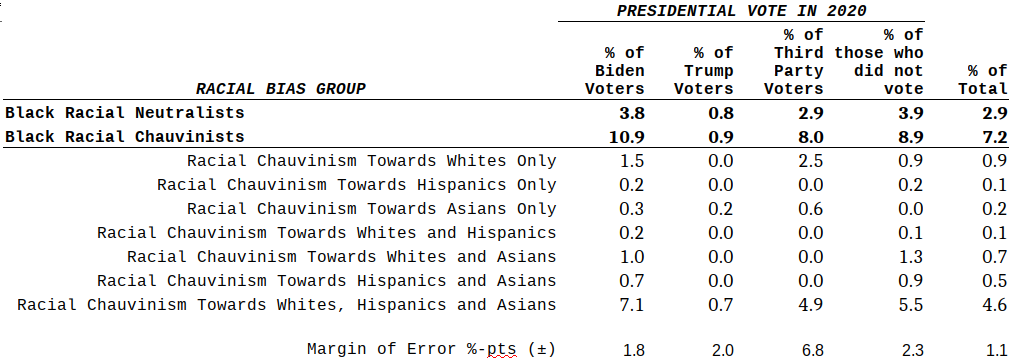
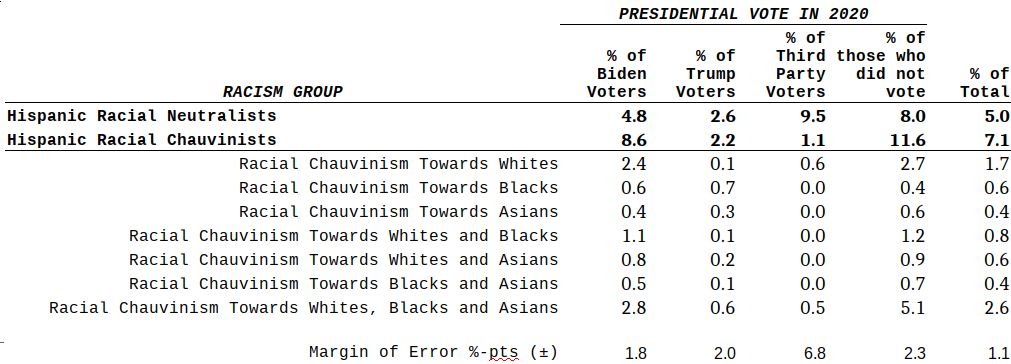
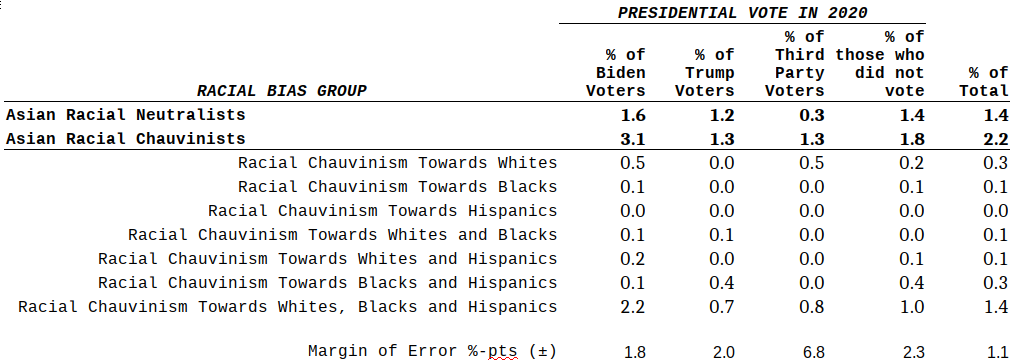
So, while a Trump voter is significantly more likely to be a white racial chauvinist than a Biden voter, when one adds the Black, Hispanic and Asian voters who are racial chauvinists to the mix, the percentage of Biden voters who are racial chauvinists turns out to be virtually the same as for Trump voters (i.e., about one-third).
Figure 3 reveals the issue. The reality is that over half of Black, Hispanic, and Asian Americans hold racially-biased attitudes towards other races and ethnicities (63.3 percent, 54.1 percent, and 57.8 percent are racial chauvinists, respectively). In contrast, only 26.7 percent of whites are racial chauvinists.
Figure 3: Racial/ethnic bias within the 2020 U.S. electorate (by eligible voter’s race/ethnicity)
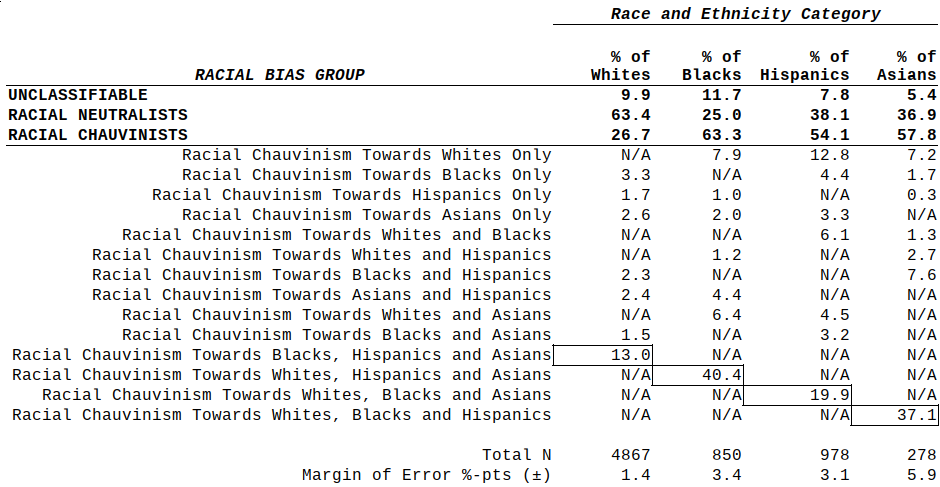
Even if we remove racial biases against whites from the equation, 55.4 percent of Black Americans possess racial biases against Hispanics and/or Asian Americans. Similarly, 41.3 of Hispanics and 50.6 percent of Asians hold racial biases against the other non-white racial and ethnic groups.
Judge not, that ye be not judged (Matthew 7:1)
There is a compelling argument within the racism-focused academic and activist communities that says Black Americans (and racial/ethnic minorities, in general) can’t be racist because racism requires a “power-over” relationship. Writes pastor and anti-racism activist Joseph Barndt:
“Racism goes beyond prejudice. Racism is the power to enforce one’s prejudices. More simply stated, racism is prejudice plus power.” [Dismantling Racism: The Continuing Challenge to White America (Minneapolis, 1991), 28.]
One reason I prefer the label ‘racial chauvinism’ to that of ‘racism’ in this essay is that the 2020 ANES survey items I use here are attitudinal measures, not behaviors. Thus, I use terms like chauvinism, prejudice, or bigotry as attitudinal indicators and reserve terms like racist or racism for the active implementation of prejudiced attitudes.
I acknowledge this may be pure semantics, but I have found this distinction useful in the past when analyzing racial bias, particularly in the context of survey-based data.
In the end, I am sympathetic to the argument that a white racial chauvinist generally occupies a different position in our society than a Black, Hispanic or Asian racial chauvinist;and, therefore, should not be treated as a substantive or operational equivalent.
Combined with institutional racism and demographic size disparities, white racial chauvinism is substantively more impactful in the aggregate.
Nevertheless, it is also wrong to ignore racial and ethnic prejudice existing within the non-white communities making up the Democrats’ electoral coalition.
Racial scholar Lawrence Blum, Professor of Liberal Arts and Education at the University of Massachusetts, concludes:
“Contemporary use of the vocabulary of racism no longer confines it to whites; Chinese, blacks, Japanese, Latinos, and other people of color are recognized to include in their ranks racially bigoted persons and, more broadly, to be subject to racial prejudices. These attitudes can be directed toward other groups of color, toward whites, or toward members of one’s own group. People of color are also capable of developing belief systems based on racial superiority, in which some groups of color are superior and whites or other groups of color are inferior…In my view, these attitudes and beliefs are all racist, and current usage generally so refers to them.”
Highlighting some sources of racial bias and prejudice while ignoring others is most likely not helpful in the long run and, frankly, paints a distorted picture of reality.
As such, media-driven tropes about the alleged tolerance within Republican ranks for ‘white supremacists’ are not just inaccurate, they are counterproductive if our goal is to achieve lasting progress in U.S. racial relations.
Given that 10 percent of Biden’s voter support in 2020 came from white chauvinists, it is time for Democrats to stop pretending the racial bias problem is isolated to Donald Trump supporters.
It is not.
- K.R.K.
Send comments to: nuqum@protonmail.com
All data and SPSS computer programs used in writing this essay are available on GITHUB ==> HERE.
The science of creativity and the forever effervescent Syd Barrett
By Kent R. Kroeger (May 4, 2021)

“There is no great genius without a touch of madness.” — Aristotle (384 BC–322 BC)
“You are only given a little spot of madness, and if you lose that, you are nothing.” — Robin Williams (1951–2014)
“I know a mouse, and he hasn’t got a house. I don’t know why, I call him Gerald.” — Syd Barrett (1946–2006)
_________________
Just suppose clouds had strings attached to them which hang down to earth. What would happen?
How you answer this question may not only indicate your level of creativity, but also the likelihood you suffer from mental illness.
That was the discovery of neuroscientist Szabolcs Kéri of Semmelweis University in Hungary in a 2009 study that found a link between the presence of neuregulin 1, a gene commonly associated with psychosis and depression, and a person’s level of creativity.
“Molecular factors that are loosely associated with severe mental disorders but are present in many healthy people may have an advantage enabling us to think more creatively,” says Szabolcs.
In Szabolcs’ study, volunteers were asked a number of nonsensical questions like the ‘cloud’ question above. Szabolcs and his research team then assigned a creativity score to each study participant based on the originality and flexibility of their answers. Along with this assessment, the participants listed their lifetime creative achievements and provided blood samples.
“The results show a clear link between neuregulin 1 and creativity. Volunteers with the specific variant of this gene were more likely to have higher scores on the creativity assessment and also greater lifetime creative achievements than volunteers with a different form of the gene,” concluded Szabolcs and his research team.
There is also a 2010 study that tracked 700,000 Swedish 16-year-olds over ten years, which found that people who were high academic achievers at 16 years of age were four times as likely to be diagnosed with a bipolar disorder later in life.
In a 2012 science symposium that included a panel on the mental illness-creativity link, James Fallon, a neurobiologist at the University of California-Irvine, suggested that bipolar disorder and creativity share a common brain pattern:
When people are being creative, activity in the lower part of their frontal lobe decreases but rises in its higher regions — this is exactly what happens as well with bipolar patients when they come out of a deep depression.
Also on that panel, Elyn Saks, a mental health law professor at the University of Southern California, noted that people with psychosis have difficulty filtering out stimuli and therefore are more likely to hold contradictory or unrelated ideas simultaneously. While this result may make them appear ‘scatter brained,’ it may also unlock a degree of intellectual freedom necessary for producing something unique and profound.
As Aristotle’s quote indicates, observations of a link between genius and madness is as old as civilization itself.

Weep for the fragile poets who were overtaken by the monster
Rock-n-Roll history is strewn with creative talents also known for their intermittent madness. John Lennon. Kurt Cobain. Jim Morrison. Amy Winehouse. Janis Joplin. Michael Jackson. Phil Spector. Prince. Brian Wilson. Peter Green. Bjork.
But none is more fascinating than Syd Barrett, who gained rapid fame as the creative leader of Pink Floyd during 1967’s Summer of Love. Sadly, he would be out of the band by early January 1968, and died of pancreatic cancer in 2006 in near anonymity, save for a few die-hard Floyd fans who remembered his short but explosively innovative tenure with the band and as a solo artist.
The original Floyd line-up in 1965 consisted of Roger Waters (bass guitar), Richard Wright (keyboards), Nick Mason (drums) and Barrett (lead guitar), with Barrett as the primary songwriter on the band’s first album, The Piper at the Gates of Dawn, and first two hit singles(Arnold Layne and See Emily Play).
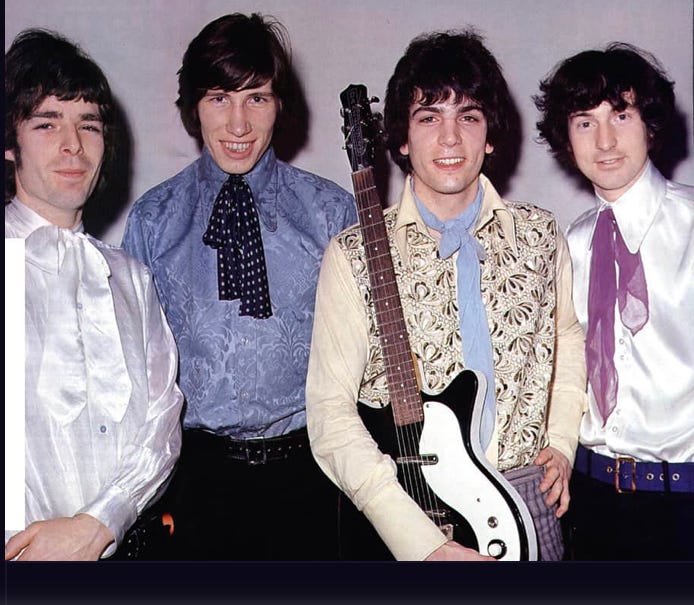
Given the competitive, ruthless nature of the music industry, it is not that unusual to get kicked out of a band, even one you helped start. Think Brian Wilson (The Beach Boys), Brian Jones (The Rolling Stones), Steven Adler (Guns-n-Roses), Mick Jones (The Clash), Glen Matlock (The Sex Pistols), or Dave Mustaine (Metallica).
[Matlock’s involuntary exit from The Sex Pistols is particularly amusing given the band’s hardcore punk reputation: He talked too much about how he admired The Beatles, especially Paul McCartney.]
With all due respect to Brian Jones, who drowned only a month after getting booted from The Stones, no rock band departure is more tragic or iconic than Barrett’s.

The superficial facts alone surrounding Barrett’s dismissal from Floyd would be enough for legend. For starters, Barrett was replaced by his close friend, guitarist David Gilmour, who he met during their school days. Even more grimacing is how Barrett learned of his removal: The band stopped picking him up in the van they were taking to gigs. In a 1995 interview for Guitar World, Gilmour told of how the decision was finally made to kick Barrett out of the band: “One person in the car said, ‘Shall we pick Syd up?’ and another person said, ‘Let’s not bother.’”
That is as artless as it is cold.
Now there’s a look in your eyes, like black holes in the sky
But Barrett’s termination in early 1968 was not without cause. During live performances shortly after Floyd’s first UK hit, Arnold Layne, Barrett would occasionally stop playing mid-concert — in some instances, turning his back to the audience as the band continued to play.
Humble Pie drummer Jerry Shirley, who worked on Barrett’s first solo album (The Madcap Laughs), found Barrett “unnerving,” according to Barrett biographer Mike Watkinson,
“You could have a perfectly normal conversation with him for half-an-hour then he would suddenly switch off and his mind would go off somewhere else,” Shirley told Watkinson.
Shirley noticed another quirk in Barrett’s personality — his laugh: “Syd had a terrible habit of looking at you and laughing in a way that made you feel really stupid. He gave the impression he knew something you didn’t. He had this manic sort of giggle which made The Madcap Laughs such an appropriate name for his album — he really did laugh at you.”

In a 1978 interview with journalist Kris DiLorenzo, Shirley shared his observations about Barrett’s last days in Floyd:
“It was getting absolutely impossible for the band…Onstage he would either not play or he’d hit his guitar and just turn it out of tune, or do nothing. They were pulling their hair out, they decided to bring in another guitarist to complement, so Syd wouldn’t have to play guitar and maybe he’d just do the singing. Dave (Gilmour) came in and they were a five-piece for about four or five weeks…Then the ultimate decision came down that if they were going to survive as a band, Syd would have to go. Now I don’t know whether Syd felt it and left, or whether he was asked to. But he left. Dave went through some real heavy stuff for the first few months. Syd would turn up at London gigs and stand in front of the stage looking up at Dave; ‘That’s my band.’”
Job loss in rock-n-roll doesn’t get more awkward, and had Barrett just been an unpleasant dick, he would be little more than a footnote in rock history.
But Barrett was supremely creative and his dickish behavior seemed, at least to those who knew him best, to be correlated with his increased use of acid just as the band was becoming an international phenomenon.
Among those who knew him before the Floyd fame, he was an engaging, likable young man. “He was always laughing, and always had a huge sparkle in his eyes as a child,” remembered Syd’s sister, Rosemary Breen, in an interview with the BBC’s John Harris shortly after Syd’s death in 2006. “He was exceptionally gifted and always had loads and loads of friends.”
One of his first girlfriends, Jenny Spires, met Barrett at 15 years old when he was 18, and said about him: “He was a lovely person, and my parents liked him too. My dad knew of his dad, and he and my mum just hit it off, so they felt very safe with me going around with him.”
Barrett’s bandmate and close friend, Richard Wright, briefly lived with him in 1967–8 as part of the band’s attempt to nudge him back into normalcy, and observed his descent firsthand. In a BBC interview, Wright recalled:
“There were two Syds. There was the pre-acid and the post-acid, and the pre-acid Syd was just this wonderful, open and flamboyant guy. And, clearly, we were all hoping he’d get better and all desperately trying as hard as possible to keep him in the band — we all loved him.”
“He was a great talent, but he was also bloody difficult,” was the inelaborate description of Barrett offered by Floyd’s drummer, Nick Mason.
The once charismatic and outgoing art student from Cambridge vanished, and in the span of a year, Barrett would withdraw into a mental lockbox that no one knew how to unlock. In 1968, at the cusp of Beatlesque-like stardom, something had caused seemingly irreversible changes to Barrett’s captivating, though quirky, personality. But what?
His excessive use of LSD has become the accepted myth.
“Roger (Waters) had a theory he was schizophrenic. I don’t think he was. But I’m still convinced he took a huge overdose of acid and destroyed his brain cells,” said Wright, who died in 2008 of lung cancer.
Yet, there remains significant doubts within the medical community as to whether LSD actually kills brain cells and creates life-disabling psychoses.
“So far, there’s not much evidence to suggest that LSD has long-term effects on the brain,” according to Zara Risoldi Cochrane, Pharm.D., M.S., FASCP and Adrienne Santos-Longhurst. “A large survey published in 2015 found no link between psychedelics and psychosis. This further suggests there are other elements at play in this connection, including existing mental health conditions and risk factors.”
Though the cause of Barrett’s mental decline is disputed, the result is not.
After his dismissal from Floyd, Barrett would in 1970 record two solo albums (The Madcap Laughs and Barrett), but never achieved anything close to the commercial success Floyd would enjoy in the 1970s.
Soon after Barrett’s last live performance on June 6, 1970 at Olympia Exhibition Hall in London, with Gilmour joining him onstage on bass guitar, he left the music business and eventually moved in with his mother and sister in Cambridge.
Apart from an unannounced visit to Abbey Road studios in 1975 — where his former band, ironically, was mixing the song Shine on You Crazy Diamond whichthey had written about their former bandmate — Barrett disappeared from public life.
And so began the growing myth of Syd Barrett.
An effervescing elephant with tiny eyes and great big trunk
As is usually the case, myth typically exaggerates reality, especially as time passes. As an example, try as I do to appreciate the comedic brilliance of late comedian Lenny Bruce, I just don’t find him funny — not even a little. [Here is one of his more accessible appearances: The Steve Allen Show — April, 5, 1959.]
And I could see a hundred more Jackson Pollack paintings and still think my dog with paint brushes tied to his paws could create something just as thoughtful.
Similarly, not every music critic appreciates Syd Barrett’s songs or musicianship. His lead guitar playing could range from powerful to hellishly inventive to sloppy to ‘What the hell is he doing?!’ — sometimes all within the same song. As for his songs, some would include unusual chord changes or chords that don’t even exist (such as at the 0:43 mark in Dark Globe), while others could change time signatures multiple times, making them difficult for other bands to cover (e.g., Bike from The Piper at the Gates of Dawn).
Rock critic Bill Wyman (not to be confused with The Rolling Stone’s bassist) wrote of Barrett’s songs:
“The argument against Syd Barrett is that, to use a turn of phrase he might have heard in his Cambridge days, even his best songs are curate’s eggs — parts, that is to say, are excellent. But that’s as far as it goes with all but a few of the songs he’s left behind. I respect the Barrett amen corner; but the plain truth is that it’s hard to come up with one Barrett song that’s as good as, say, (The Kink’s) Waterloo Sunset or even (Status Quo’s) Pictures of Matchstick Men.”
Matched against Waterloo Sunset, a pop music masterpiece, few popular music songs survive the comparison. And the brevity of Barrett’s productive songwriting years (1966–1970) must also be considered before making connections to the Ray Davies, Leiber-Stoller, Lennon-McCartney, or Jagger-Richards song catalogs.
Furthermore, Barrett’s experimentalism observed no restrictions when he and his bandmates took rock music down a path that sometimes, to my Beatle-nurtured ears, created sounds similar to that of a gang of feral cats attacking a bad teenage garage band. The last two-and-a-half minutes ofPow R. Toc H., co-written by Barrett with Waters, Wright and Mason, is representative of that modal apocalypse. It’s basically nails-on-chalkboard screeching noise.
However, Barrett’s best songs, while often unpolished and in need of a George Martin-like influence in the studio and editing phases, still stand the test of time and cover a stylistic and lyrical range as broad as the best popular artists of his time, including Ray Davies and Lennon-McCartney.
On Barrett’s death in 2006, David Bowie said “Syd was a startlingly original songwriter.”
Nonetheless, Wyman insists Barrett’s music revealed his “promise,” not evidence of his genius. From the perspective of musicality, I can accept his conclusion, but I would add that ‘genius’ and ‘creativity’ are not synonyms. Barrett was a creative savant who may well have lacked the comprehensive knowledge and discipline to earn the additional label of ‘genius.’ [I like to point out during discussions like this that Albert Einstein, who fundamentally reshaped the field of physics and our understanding of the universe, also lacked the discipline necessary to finish his PhD.]
If I had to make a comparison, Barrett’s songs are reminiscent of John Lennon’s ability to blend free-associative lyrics with strident rock guitar melodies, à la I Am The Walrus or And Your Bird Can Sing. And Barrett, like Lennon, had a preternatural knack for writing memorable and hummable pop ditties.
The Barrett song that best exemplifies that for me is one he wrote as a teenager — Effervescing Elephant, recorded for the 1970 album “Barrett.” On a first listen, it sounds like little more than a catchy children’s song, like a tune out of Walt Disney’s The Jungle Book. But with subsequent listens a listener starts to recognize its unpretentiously clever and dark lyrics are quite remarkable — a lyrical revelation that stands with Lennon’s best:
An Effervescing Elephant
With tiny eyes and great big trunk
Once whispered to the tiny ear
The ear of one inferior
That by next June he’d die, oh yeah!
Because the tiger would roam
The little one said, “Oh my goodness I must stay at home”
And every time I hear a growl
I’ll know the tiger’s on the prowl
And I’ll be really safe, you know
The elephant he told me so
Everyone was nervy, oh yeah!
And the message was spread
To zebra, mongoose, and the dirty hippopotamus
Who wallowed in the mud and chewed
His spicy hippo-plankton food
And tended to ignore the word
Preferring to survey a herd
Of stupid water bison, oh yeah
And all the jungle took fright
And ran around for all the day and the night
But all in vain, because, you see
The tiger came and said “Who me?
You know I wouldn’t hurt not one of you
I’d much prefer something to chew
And your all to scant.” Oh yeah!
He ate the elephant
Why I am teaching Barrett songs to my son
Whether or not Syd Barrett ‘fried’ is brain on LSD is immaterial at this point. And I don’t believe ‘madness’ is a necessary companion to creativity. I’ve met some very creative people who are also very sane.
Indisputable, however, is that for a brief moment in rock history some wonderful music and words flowed from Barrett’s mind that were so creative — so celestially inspired — that they sound as insurgent today as they must have seemed fifty years ago.

Today, as I sat with my son in our home’s music room, guitars in hand and Fender amps in the ready, we started to master fingering and strumming a A7 — C — Dm chord progression in the hope that we can perform, with passable merit, my favorite Barrett song, Dominoes.
At the time of his death in 2006, I only knew Barrett as ‘the guy who left Pink Floyd before they became really famous.’ Since then, it has taken my own personal struggles, along with helping my teenage son prepare for life’s inevitable challenges, to fully appreciate Barrett’s creative purpose. I feel at peace when I play his songs.
Roger “Syd” Barrett, we are grateful for what you’ve left us.
- K.R.K.
Send comments to nuqum@protonmail.com
The 15 Essential Syd Barrett Songs
[Click on song name to hear]
15. Maisie (from Barrett, 1970) — Syd loved the Blues (along with Jazz); accordingly, this song is musical swamp water.
14. Effervescing Elephant (from Barrett, 1970) — Closing Syd’s second solo album, this song probably deserves to be higher on the list; it is clever, snappy and would be a cherished chestnut in any other songwriter’s catalog.
13. Jugband Blues (from A Saucerful of Secrets, 1968) — Syd’s goodbye letter to his bandmates; in the song’s promotional video, at the song’s end, Syd turns to Roger Waters after he sings, “And what exactly is a dream? And what exactly is a joke?” — it is heartbreaking.
12. Lucifer Sam (from The Piper at the Gates of Dawn, 1967) — A combination of James Bond and Lewis Carroll; it is apparently a song about Syd’s cat.
11. Octopus (from The Madcap Laughs, 1970) — I love the Bo Diddley tribute in the middle.
10. Love You (from The Madcap Laughs, 1970) — I heard this song at a wedding once; a fun, bouncy tune that changes time signatures more times than Lady Gaga changes costumes in concert.
9. Terrapin (from The Madcap Laughs, 1970) — An “easy” song to learn but, strangely, hard to play.
8. Bob Dylan Blues (released in 2001) — Recorded in 1969 (or thereabouts), this song both mocks and honors Bob Dylan.
7. See Emily Play (Pink Floyd’s second single; released in Nov. 1967) — This song proves Pink Floyd was a different band with Syd as the front man.
6. Arnold Layne (Pink Floyd’s first single; released in March 1967) — The song’s video is lifted straight out of A Hard Day’s Night; andthe song’s A to F# chord changes still give me chills.
5. Here I Go (from The Madcap Laughs, 1970) — Syd’s best self-referential song that also highlights his great voice when singing in a low register.
4. Baby Lemonade (from Barrett, 1970) — The opening song on his second solo album; the oft-repeated chorus may only be five seconds long, but it is guaranteed to raise the hair on your neck.
3. Bike (from The Piper at the Gates of Dawn, 1967) — Probably Syd’s most recognized song; for good reason, it’s deceptively childlike, quirky lyrics ride on top of a Beatlesque melody that is impossible to get out of your head once heard.
2. Interstellar Overdrive (from The Piper at the Gates of Dawn, 1967) — a psychedelic rock masterpiece with an opening lead guitar that stands up to anything heavy metal would produce in subsequent years; if I were starting a rock band, we’d open every concert with the first 50 seconds of this song.
1. Dominoes (from Barrett, 1970) — One of those simple Syd songs that shows his “promise” as some prefer to call it; in truth, the song is haunting and brilliant — I wouldn’t change a note. [David Gilmour’s live version is worth a listen too.]
Honorable mentions:
Vegetable Man (recorded by Pink Floyd in 1967, but unreleased until 2016) — This is the song Syd came up with for Pink Floyd’s third single and now marks what was probably the end of Syd’s relevance to the band; it was uncategorically rejected by the record company and would go unreleased for five decades; yet, if you heard it today, you would be forgiven if you thought it was a punk rock classic. Syd was ahead of his time.
Astronomy Domine (from The Piper at the Gates of Dawn, 1967) — Another group effort by Pink Floyd, but Syd’s guitar dominates; and while I prefer Interstellar Overdrive, this song remains firmly in the pantheon of psychedelic rock’s greatest songs.
Milky Way (from Opel, 1988, a collection of unreleased Syd solo compositions recorded around 1970) — The world is a pretty lonely and scary place when your reality is not the same as others’ around you; this song puts that sentiment to music.
Clowns and Jugglers (from Opel, 1988) — This may just be a remixing of Octopus, from The Madcap Laughs, but more than a few Syd fans prefer this version; Lennon was doing musical cacophonies like this in the late 1960s (take a listen to What’s the New Mary Jane), but Syd’s scattered madness was more than its musical match.
Re-imagining law enforcement (Part 1)
By Kent R. Kroeger (Source: NuQum.com, April 21, 2021)

“We need to re-imagine policing and public safety in this country”
— Barack Obama, April 12, 2021
Today, as many people are expressing a sigh of relief at the conviction of Minneapolis police office Derek Chauvin in the May 2020 murder of George Floyd, I was reminded of an essay I wrote a year ago about the too common use of excessive force by police in the enforcement of minor civil violations.
Many journalists and commentators have emphasized that the reason Minneapolis police engaged with George Floyd on May 25,2020 in the first place was over Floyd allegedly passing of a counterfeit $20 bill at a local convenience store — the presumption being that had this happened in an affluent community, the police never would have been called or, if they were called, would not have acted as they did towards Floyd.
“This man lost his life over a $20 bill?” singer-songwriter Tom Prasada-Rao lamented to a local Portsmouth, Virginia reporter.
But it is not just the Floyd incident. Here are other cases where the police used excessive (and sometimes deadly) force in the course of investigating a minor crime:
On July 17, 2014, Eric Garner was killed after a New York City police officer used a prohibited chokehold during his arrest on suspicion of selling individual cigarette without the legally required tax stamps on the packs. (Video)
On April 4, 2015, a South Carolina police officer shot Walter Scott in the back as he fled from the officer. Why was Scott initially stopped? A broken brake light on his car. (Video)
On Dec. 5, 2020, Windsor, Virginia police officers pulled over U.S. Army 2nd Lt. Caron Nazario, who was returning home from his duty station, for not having a rear license plate on his newly purchased Chevrolet Tahoe SUV. In the course of questioning Nazario, who initially refused to step out of his vehicle out of fear, the officers pulled their guns and sprayed him with a substance meant to subdue him. (Video)
More recently, on April 12, 2021, Daunte Wright, who had been pulled over for an expired registration tag on his car, was killed by a Brooklyn Center, Minnesota police officer who says she accidentally pulled her gun instead of her taser in the process of subduing Wright. (Video)
As Irish poet Brendan Behan once said: “I have never seen a situation so dismal that a policeman couldn’t make it worse.”
Behan’s observation is not entirely balanced, however, as seen in the incidents I have referenced above: Suspects often demonstrate their own special knack for making their situation worse.
Still, the nature of an alleged crime must be considered when judging whether law enforcement is justified in its use of force. Blaming the victim for their emotional, sometimes counterproductive reaction to an engagement with law enforcement does not feel constructive.
It is, in my opinion, the duty of law enforcement professionals to deescalate, when at all possible, any interactions with civilians — particularly when that interaction is concerning a relatively minor offense.
And that includes situations (such as this one) where police arrest citizens who refuse to wear masks in private establishments that require masks. I understand the importance of wearing masks during a pandemic, but I don’t understand why elderly women need to be taken to the ground and handcuffed for such non-compliance. There are better (safer) ways to handle these situations.
Therefore, in the shadow of the Derek Chauvin verdict, I offer my original essay on police enforcement of minor law violations and our need to re-imagine how law enforcement engages with the citizens they take an oath to protect:
Our law enforcement officers need new rules of engagement for minor crimes (May 26, 2020)
By Kent R. Kroeger (NuQum.com)
As a society we’ve become accustomed to seeing awkwardly shot cellphone videos of police officers using excessive force against African-American males.
Michael Brown, Eric Garner and Freddie Gray. We know the names even if we don’t remember the details.
And with each new incident, the predictable responses on social media emerge: “If you’re smart, you do what the officer tells you to do,” “The police have to protect themselves” or “Why was he resisting arrest?”
Such reactions are understandable, though not particularly helpful or insightful.
However, an apparent excessive force incident from about nine months ago in Oklahoma put a slight twist on things. In the following video — shot by the police officer’s body cam — the subject who was taken aggressively to the ground and subsequently tased is a 65-year-old woman:https://cdn.embedly.com/widgets/media.html?src=https%3A%2F%2Fwww.youtube.com%2Fembed%2F7CvErhrFwuo%3Ffeature%3Doembed&display_name=YouTube&url=https%3A%2F%2Fwww.youtube.com%2Fwatch%3Fv%3D7CvErhrFwuo&image=https%3A%2F%2Fi.ytimg.com%2Fvi%2F7CvErhrFwuo%2Fhqdefault.jpg&key=a19fcc184b9711e1b4764040d3dc5c07&type=text%2Fhtml&schema=youtube
Don’t assume social media was sympathetic to her case just because she was an older woman and the purpose for the traffic stop was a defective tail light.
“You can tell this lady has been getting her way for years. Well not anymore.” (Benji)
“Turns an $80 ticket in to a felony pursuit. Brilliant.” (Anonymous)
“Result of when you’re used to getting everything you want for the past 70 years.” (Stephanie)
“I don’t feel any sympathy for this lady. She got what she deserved.” (Janae)
“I don’t know what level of entitlement she thinks she is due, but MAN was I satisfied when she got tased.” (Kimberly)
Nobody enjoys the snarkiness of social media more than I do, but my reaction to this video was somewhat different.
Here is where I agree with the majority of comments:
First, the woman’s reaction to the traffic stop was entirely inappropriate. She had been driving for six months with a broken tail light (presumably she was previously stopped for this violation) and she expects she can talk her way out of a ticket?
Um…no. Not going to happen.
Second, of all the things not to do during a routine traffic stop, the woman decides to drive off. Sweet Jesus, what did she expect would happen next?
The bottom line here: she’s at fault and the Cashion, Oklahoma police chief would have no reason to discipline this police officer.
Even within police departments with strict rules of engagement — where use of force is highly circumscribed — a police officer in this situation would be trained to draw his firearm and subdue the woman, including the use of a taser if necessary. A woman willing to drive away from a traffic stop, no matter how old, may be armed and dangerous.
But the fact that this is allowable police behavior is part of a much bigger problem within law enforcement: The basic theory guiding law enforcement’s rules of engagement must fit the crime.
The Context
The current social and political context makes reforming rules of engagement more important than ever for police departments. Some Americans (Blacks and Hispanics, in particular) have understandably grown more distrustful of the police.
Since 1993, according to the Gallup Poll, the average American citizen’s confidence in the police has narrowly ranged between 52 percent and 64 percent having “a great deal” or “quite a lot” of confidence (see Figure 1).
Figure 1: U.S. Confidence in the Military, Police and Small Business over time

Source: The Gallup Poll
However, for Black Americans, their trust in the police fell from 35 percent in 2012–14 to 30 percent in 2015–17. Over the same period, those numbers dropped from even farther for Hispanics from 59 percent to 45 percent. Other research has also shown that whites living in high-crime areas also display lower levels of trust in police comparable to Black and Hispanic’s living under similar circumstances.
From the perspective of police, there is evidence that hostile media portrayals of police actions have increased officers’ belief that civilian attitudes and behaviors toward police have worsened over time.
This possible downward spiral of trust and legitimacy between some communities and law enforcement could be toxic and whether those intertwined forces were at play with the woman and police officer in Oklahoma is uncertain, but definitely plausible.
Which is why I believe, now more than ever, the police need to rethink their rules of engagement in routine situations like the one in Oklahoma.
What happened didn’t need to happen and the burden to make sure it doesn’t happen must rest with the police.
Let us re-examine what happened in Cashion, Oklahoma to see how this situation could have been resolved much more peacefully. And, keep in mind, the highest priority for police departments when their police officers justifiably use force is the safety of those officers.
Early in the traffic stop, both the officer and woman are actually cordial with one another, though clearly the woman is annoyed. On the Federal Law Enforcement Training Center’s Use of Force Model, the interaction between citizen and officer is still in Level 1 (see Figure 2).
Figure 2: Federal Law Enforcement Training Center’s Use of Force Model

A use-of-force continuous scale developed by the Federal Law Enforcement Training Center.
At 0:29 in the video, however, the officer ceases to entertain the woman’s passive plea that she should not be fined for a safety equipment violation and asks her to leave her truck so he can arrest her.
Stop right there.
By the officer saying he was going to arrest the woman, his range of options for deescalating the conflict significantly narrowed. On the Use of Force scale, he’s on already Level 3, even as the woman is merely complaining that she doesn’t deserve an $80 ticket.
At 0:47, the officer says again, “You’re under arrest,” to which she replies, “No, I’m not.”
At this point, this incident isn’t going to end with anything but the woman being handcuffed and taken to the police station…over an $80 safety violation on her truck.
Also not helping the situation, the officer’s ego is now threatened if she does not immediately submit.
Arrests are emotionally violent acts, if not physically violent. The natural human reaction at being arrested therefore is often fight or flight.
At 1:04, the woman makes the unfortunate decision of choosing flight and drives off in her truck.
At 1:13, the officer has caught up to her and has his gun drawn as he approaches the woman’s truck. The incident is somewhere between Levels 3 and 4 on the Use of Force scale at this point.
All of this drama over an $80 safety equipment violation.
At 1:32 in the video, she is pulled out of the car and taken to the ground, at which point the officer tries to get her hands behind her back so he can cuff her.
When he fails to get the cuffs on, he pulls out his taser gun and uses it on the woman.
All because of an $80 safety equipment violation.
After he’s cuffed the woman, the officer asks her if she realizes she’s “gotten herself in a whole lot more trouble” for running off in her truck.
It almost sounds like a parent speaking to a child. And before you hoot and howl at how some adults aren’t much more emotionally developed than children, it is not the job of our police to raise us to be good adults. Their job is to protect and enforce. To the extent education is part of their job, it is not as a parent-to-a-child — and that is exactly how this interaction in Oklahoma comes across.
What possibly could have changed this outcome and still convey to the woman that, in the future, she must comply with vehicular safety equipment laws?
How do we get to the desired final outcome without the violence?
The problem starts with the law which requires ticketing officers to get a signature from the accused acknowledging the accused will appear in court. The signature, of course, does not imply guilt. It merely allows the accused to avoid getting arrested.
That seems like a good thing: I don’t have to get arrested for a broken tail light!
This legal requirement however makes the first direct, verbal interaction between the ticketing officer and the citizen a necessity. It cannot be avoided.
But why is that? We can get speeding tickets and traffic signal violations based merely on traffic cam evidence, why can’t the same be true for other plainly visible violations?
According to FindLaw.com, the issue is that localities using traffic cameras for enforcement must provide a warning sign, such as a green-yellow-red traffic light, a stop sign, or a speed limit sign. I’ve never seen a “Are your tail lights working?” sign.
“But I didn’t know my tail light was broken, officer!”
Not an excuse, drivers are supposed to know their vehicle is road safe every time they get in it and drive.
So, no, passive traffic cam enforcement isn’t going to work in the Oklahoma lady’s case. She had a broken tail light.
But there is a key moment in the Oklahoma incident where the need for a signature is OBE (overtaken-by-events).
When she drives off, she’s fleeing the scene of an alleged crime where she is the suspect.
At that point, why should the officer go after her? Unless he suspects a more serious crime is taking place and the traffic violation is merely a pretense to get the driver and truck stopped, why can’t the officer let her drive off?
I can already share the answers I’ve received to that question.
“It sets a bad example.”
“Some people will think they never need to obey the police.”
“Police can’t do their jobs if people can drive away.”
“If we don’t enforce minor laws, people will think they can commit more serious crimes.”
Those answers may all contain truths, but don’t forget, she drove off (a felony) after refusing to accept an $80 ticket for a broken tail light. This is not a high crime, even with the felony aspect. And, no, thinking I can drive away from a vehicle safety ticket doesn’t necessarily make me more likely to rob a bank.
More importantly, our law enforcement establishment and other legal authorities have many tools proportionate to the crime to penalize this woman and ensure her compliance with the law in the future.
If at 0:47 in the video, instead of telling the woman she was going to be arrested, the officer could have said, “If you refuse to sign this ticket, I have your license plate number, this car will be impounded and you will face additional fines, possibly even jail time.”
If she decides to drive off, from that point forward, the municipal authority can levy fines that, if ignored, can be increased appropriately. The authorities can prevent her from receiving local licenses and approvals (business, hunting, home improvement, etc.), as well as other punishments, which can be applied without arresting her and putting her in jail.
But do not misunderstand my proposal. Once a police officer says, “You are under arrest,” driving off or fleeing is a serious crime. What I am proposing is a rule of engagement that avoids an officer needing to say, “You are under arrest.”
Of course, people cannot flout the law, no matter how minor the offense. But the scale of the punishment and how it is enforced is equally important.
In my opinion, throwing a 65-year-old woman resisting arrest to the ground and using a taser on her is not appropriate given her crime is refusing to accept a ticket for a vehicle safety violation and driving off.
Vehicle Safety Laws Are Important
One last comment I received to the first draft of this essay deserves some attention.
“You diminish the seriousness of vehicle safety laws which can, when violated, lead to accidents and deaths.” (My wife)
That comment resonates with me and I do not consider such laws as unimportant. They are, in fact, critical to community safety.
But show me the evidence that arrests like that of the woman in Cashion, Oklahoma lead to better overall outcomes for a community than my solution (let her drive off, impound the vehicle, impose additional fines).
One cannot assume arresting people makes them more compliant in these types of crimes.
I suspect they do not, and may even cause the exact opposite outcomes.
- K.R.K.
Send comments, traffic fines and arrest warrants to: kroeger98@yahoo.com Or tweet to: @KRobertKroeger1
Facts out of context can be as treacherous as lies

By Kent R. Kroeger (Source: NuQum.com, April 12, 2021)
As more and more people across the world are getting vaccinated against SARS-CoV-2, the virus that causes COVID-19, daily headlines continue emphasize how this virus and its variants remain an imminent threat.
There are currently 23.9 million active COVID-19 cases in the world. That is the most at any given time during this pandemic.
Accordingly, the current number of COVID-19 related news articles are so numerous it is understandable if people are numb to them.
However, for me, one recent news story stood out from the clutter:
Four deaths after taking Russian Sputnik V vaccine (EUobserver.com, by Andrew Rettman, April 9, 2021)
“Four people recently died in Russia shortly after taking the Sputnik V anti-corona jab in previously unreported cases, which are being taken ‘seriously’ by the EU regulator, the European Medicines Agency (EMA) in Amsterdam.
Six other Russians also had medical complications after taking the vaccine, according to internal case files from RosPotrebNadzor, a Russian body responsible for administering vaccinations, seen by EUobserver.
Three of the deceased were women aged 51, 69, and 74. The fourth one was not identified in the leaked files.”
[Story downloaded on April 11, 2021]
In a world where many people already distrust their governments and medical experts, the possibility that any COVID-19 vaccine is potentially harmful or deadly only increases the likelihood that large numbers of people may never get vaccinated — for example, among U.S. Marines offered a vaccination shot, nearly 40 percent have declined to receive it.
That is why headlines like the one about the Russian vaccine (Sputnik V) demand scrutiny. Is it significant that four deaths have coincided with receiving the Sputnik V vaccine?
The short answer is probably not. As I will show below, random chance alone most likely accounts for a small number of deaths occurring soon after receiving the Sputnik V vaccine (or any safe vaccine). In particular with vaccines administered to a large percentage of a population, a certain number of negative events (e.g., death) should be expected with even the safest vaccines.
That said, this answer does not suggest any death temporally related to receiving a COVID-19 vaccine should be ignored. The fact that two of the four dead were relatively young is particularly troubling.
The purpose of the following analysis aims to show that when observing rare events in large populations, it is easy to make premature causal inferences, and the potential for this mistake is heightened when news organizations report ‘factual’ data without proper context. In the case of the COVID-19 pandemic, news organizations potentially do significant harm by sowing unsubstantiated levels of distrust in the vaccines currently available.
[I might even argue that the misapplication of objective ‘facts’ to support a false narrative is more dangerous than lies, as the latter can be often dismissed with a modicum of inquiry, while the former offers prima facie validity to a core narrative that becomes harder to disprove.]
Should those receiving the Sputnik V vaccine be worried? Here is a back-of-the-envelope look at this question…
The following analysis comes with this caveat: The Russian research organization which developed Sputnik V, Gamaleya Research Institute of Epidemiology and Microbiology in Moscow, has not been as transparent as their U.S. and European counterparts in sharing case-specific data on potential adverse reactions to the vaccine. Still, the core research supporting the regulatory approval and mass distribution of Sputnik V has been peer-reviewed and published.
The first number to consider is that from mid-January to mid-March, 3.5 million Russians have received both doses of the Sputnik V vaccine (e.g., 7 million shots). That number translates to 116,600 shots per day over the approximately 60 days the vaccine has been available to the Russian public (mid-January to mid-March).
The next important number is Russia’s overall mortality rate, estimated to be about 13,000 deaths per 1 million people annually over the 10 years prior to the COVID-19 pandemic. [For simplification reasons, I did not use age-adjusted mortality rates to account for the fact that older Russian citizens were more likely to receive the Sputnik V vaccine during the analysis period. Furthermore, given that life expectancy in Russia is around 72.7 years, it is notable that two of the women who died were significantly younger than that age. An unusually high number of deaths among people otherwise young and healthy should always raise red flags regarding the safety of a vaccine.]
This mortality rate translates to a probability of a Russian dying on any given day to be around 0.00003562 (the ratio 13,000/1,000,000 divided by 365) or a 1.3% chance over the entire year.
Applying Russia’s mortality rate to the 3.5 million Russians already vaccinated, we should expect 134 of them to die on any given day this year (or about 8,040 deaths every two months (60 days x 134 per day)).
If we multiply the 116,600 individual Sputnik V vaccinations between mid-January to mid-March by the daily probability of the vaccine recipient dying from a non-COVID-19 related cause, we get 4.2 deaths per day. In other words, on any given day between mid-January to mid-March for the 3.5 million Russians receiving the vaccine, we should have expected 4.2 Russians to die on the day they received a shot of causes unrelated to the vaccine.
Apart from one sentence buried deep in the article, the EUobserver news story offers no practical context with which to properly understand the story’s headline. If a reader were to give only a cursory amount of attention to this story, they can be forgiven if they become skeptical of Sputnik V’s safety after reading the EUobserver story.
The problem with that outcome is that it feeds an potentially irrational fear of the Sputnik V vaccine. Without systematic evidence on how Russians have reacted to the Sputnik V vaccine — not just the four leaked cases cited in the EUobserver story — it is impossible for any EUobserver reader to judge the safeness of the vaccine.
Final Thoughts
Complicating this story further is the ongoing willingness of U.S. and European news outlets to feed anti-Russian narratives at every opportunity. It is also difficult to rule out the possibility that U.S.-European pharmaceutical companies and governments, out of economic and geopolitical self-interest, are helping propagate negative and potentially false narratives about the Russian vaccine.
Which is only more reason to aggressively scrutinize news stories like the one from the EUobserver. It is unfortunate, however, that this burden rests so completely with the reader and not the news organization itself.
Should the EUobserver not have reported the Sputnik V story? Of course it should have. With the recent news of dangerous blood clots possibly associated with other COVID-19 vaccines, transparency into the numerous vaccines now on the market is critical. But when a headline reads — Four deaths after taking Russian Sputnik V vaccine — it implies a level of causation that is simply not supported by the story’s facts.
- K.R.K.
Send comments to: nuqum@protonmail.com
The coronavirus-economic growth trade off may be related to factors outside of politics
By Kent R. Kroeger (Source: NuQum.com; March 31, 2021)

If there is one thing politicians like to do, it is to brag about their uncanny foresight and leadership skills. Unsurprisingly, the coronavirus pandemic has exposed many of them as far less capable than how they present themselves.
And no politician has been exposed more by this pandemic than New York Governor Andrew Cuomo, who published a book in October 2020 (“American Crisis” — which is no longer being promoted by its publisher) about his “heroic “efforts to stop COVID-19.
The problem with Cuomo’s self-promotion effort was that the pandemic was far from over in his state when he wrote the book; and, more importantly, he failed to mention one of the titanic policy failures of his COVID-19 containment efforts (i.e., nursing home deaths).
But Cuomo is far from alone in premature braggadociousness. In her Conservative Political Action Conference (CPAC) speech in February, South Dakota Governor Kristi Noem offered this assessment of her state’s coronavirus response:
“South Dakota is the only state in America that never ordered a single business or church to close. We never instituted a shelter in place order. We never mandated that people wear masks. We never even defined what an essential business is, because I don’t believe that governors have the authority to tell you that your business isn’t essential.”
What Noem left out of her COVID-19 policy analysis is that her small, low population density state has the 8th highest COVID-19 death rate in the country (2,179 per 1 million people) and the highest among states of similar population density and demographics (see Figure 1a).
Figure 1a: States with most COVID-19 deaths (per 1 million people, as of March 25, 2021)

Figure 1b: States with fewest COVID-19 deaths (per 1 million people)
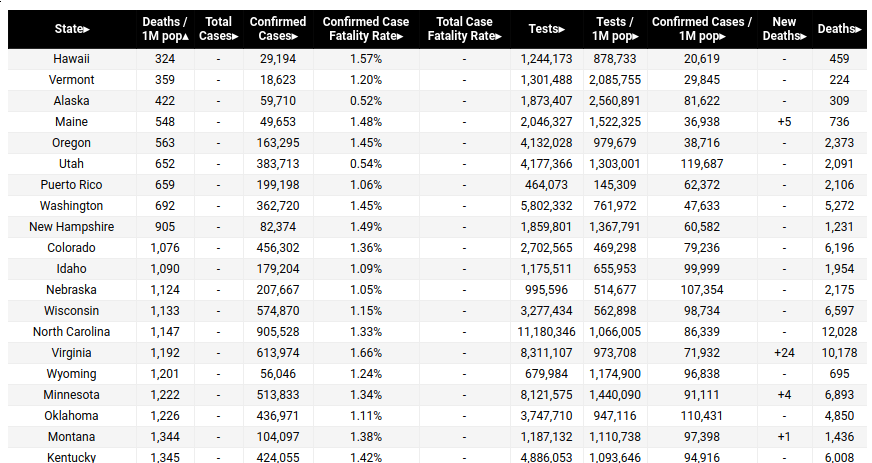
It is easy to respect Noem’s concern for keeping her state’s economy open during the COVID-19 crisis. As she put it:
“Even in a pandemic, public health policy needs to take into account people’s economic and social well being. Daily needs still need to be met. People need to keep a roof over their heads. They need to feed their families. And they still need purpose. They need their dignity. Now my administration resisted the call for virus control at the expense of everything else. We looked at the science, the data and the facts, and then we took a balanced approach.”
To her credit, South Dakota’s GDP contracted only -1.7 percent in 2020 (a preliminary estimate from the U.S. Bureau of Economic Analysis), compared to a national GDP decline of -3.5 percent and she correctly notes South Dakota’s nation-best unemployment rate. But…
…this economic stability came with a significant human cost.
Could South Dakota have done better against COVID-19 while keeping its economy stable? This question is raised in Figure 2 (below) where all 50 U.S. states (and the District of Columbia) are plotted based on their 2020 GDP growth and COVID-19 death rates (as of March 25, 2021). The chart is divided into four quadrants: (A) states with above average GDP growth and low COVID-19 death rates, (B) states with below average GDP growth and below low COVID-19 death rates, (C) states with above average GDP growth and high COVID-19 death rates, and (D) states with below average GDP growth and high COVID-19 death rates.
South Dakota resides in Quadrant C (above average GDP growth but a high COVID-19 death rate). In comparison, South Dakota’s southern neighbor, Nebraska (in Quadrant A), was able to minimize the economic consequences of COVID-19 while also keeping its COVID-19 death rate relatively low.
Figure 2: GDP Growth and COVID-19 Death Rates

Hopefully, we can agree being in Quadrant A is better than being in Quadrant D. To that point, if GDP growth and COVID-19 death rates are our key performance metrics, Utah and Washington did substantially better during the pandemic than New York, New Jersey, Rhode Island or Louisiana.
One interesting outlier is Hawaii, which, so far, has experienced the lowest COVID-19 death rate (324 per 1 million) along with the worst economic performance (a -8.0 percent decline in 2020 GDP). Hawaii’s poor economic performance is easily attributed to its high dependence on tourism for economic growth, which has largely been shutdown since the start of the pandemic; but, it should be noted that another tourism-dependent state, Florida, has had substantially better economic performance than Hawaii (-2.9 percent versus -8.0 percent GDP growth). Granted, it is much easier to drive to Florida than it is to fly or sail to Hawaii.
Also, there appears to be some geographic clustering in Figure 2. For example, the best performing states in Quadrant A are mostly from the Pacific Northwest and Rocky Mountain states (Utah, Washington, Oregon, Idaho, and Colorado), while the worst performing states in Quadrant D are largely from the Northeast and Mid-Atlantic states (New York, Connecticut, Massachusetts, New Jersey, Rhode Island and Pennsylvania).
Figure 2 begs these questions: To what extent are these differences in economic growth and COVID-19 death rates attributable to specific state-level policies? And to what extent are these differences driven by factors outside the control of the political realm, such as a state’s geographic location?
No party has had a monopoly on wisdom during the pandemic
In order to have a meaningful discussion about COVID-19 and public policy, one must first purge themselves of the biased partisan narratives — oppressive-state versus anti-science-risk-takers — that drive the current political debate and, instead, focus on the facts.
For starters, is there any substance to the common assumption in the national media that Red (Republican-dominated) states have performed worse than Blue (Democrat-dominated)statesor Purple (i.e., battleground) states (see Appendix to see how each state is classified in this analysis)?
Figure 3a shows that a state’s partisan predisposition does relate to its COVID-19 outcomes. Red states have had slightly better GDP growth than Blue states during the pandemic (-3.51 percent versus -3.69 percent, respectively), while Blue states have done significantly better than Red states in controlling the spread of COVID-19 (73,131 cases per 1 million people versus 103,090 cases per 1 million people) and marginally better in mitigating its mortality outcomes (1,439 deaths per 1 million people versus 1,558 deaths per 1 million people).
Figure 3a: COVID-19 outcomes by Blue/Purple/Red state status

And are these outcome differences associated with state-level policy differences? Figure 3b shows that the Blue/Purple/Red state distinction does, in fact, relate to COVID-19 policy differences. For example, 87 percent of Red states currently allow restaurants to be open, compared to only 50 percent of Purple states and just 20 percent of Blue states. The most striking policy difference, however, is in whether to allow ‘non-essential’ businesses to be open. Currently, only 5 percent of Blue states allow non-essential businesses to be open, compared to 50 percent of Purple states and 91 percent of Red states.
Figure 3b: Current COVID-19 policiesby Blue/Purple/Red state status
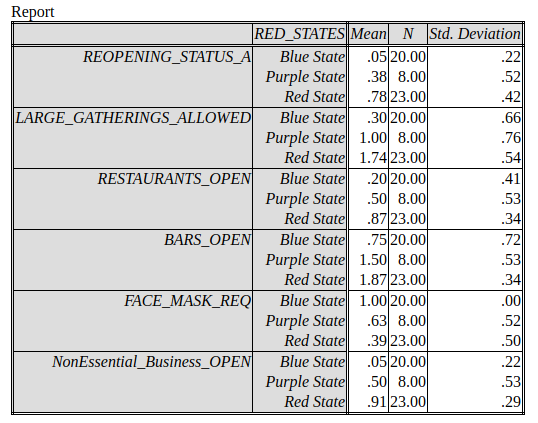
Can we attribute these policy differences to the better COVID-19 outcomes and worse economic growth in Blue states? Probably not, considering the COVID-19 outcomes are only marginally better and economic growth rates only slightly worse for the Blue states.
As Figure 2 demonstrates, when economic growth is considered together with COVID-19 outcomes, neither political party has a monopoly on policy wisdom. Almost as many Red states (Idaho, Utah, Nebraska, and Montana) are in Quadrant A as there are Blue states (California, Colorado, D.C., Maryland, Oregon, Washington and Virginia) or Purple states (Florida and North Carolina).
Which state did better? California or Florida
One of the biggest mistakes made in state-level policy analyses is that too much weight is put on small (dare I say, inconsequential) states. Why should the policies and outcomes in a state like South Dakota be put on an equal footing with a state like New York or California? Small population states undoubtedly have advantages in implementing some statewide public policies and perhaps inherent disadvantages in other instances. Small states can make for nice case studies, but are dangerous to generalize from if you are more interested in public policies nationwide.
This is why I find the comparison of COVID policies and outcomes between California and Florida to be informative. Both are large population, coastal states with relatively diverse populations and economies (though Florida is somewhat more dependent than California on tourism — which is an economic sector particularly hard hit by the worldwide pandemic).
Florida Governor Ron DeSantis has been a hot media item lately as he touts his state’s COVID-19 response, and a number of prominent media outlets have happily climbed on board his PR train. Among them, Politico, heaped this praise on DeSantis’ COVID-19 policies:
“The most controversial policies DeSantis enacted — locking down later and opening up earlier, keeping nursing homes closed to visitation while insisting schools needed to be open to students, resisting intense pressure to issue a mask mandate — have ended up being, on balance, short of or even the opposite of ruinous.”
The AP’s David Lieb recently offered this comparative insight:
“Despite their differing approaches, California and Florida have experienced almost identical outcomes in COVID-19 case rates.”
If true, why is California Governor Gavin Newsom the one facing a serious recall challenge, while DeSantis is being presented as a serious contender to be our next president?
The first answer is: Life, particularly politics, isn’t always fair. But a better answer perhaps lies in the difficulty in comparing one state to another.
On the surface, their COVID-19 and economic numbers are quite similar:
Florida: 94,665 cases per 1M / 1,543 deaths per 1M / -2.9% GDP Growth
California: 92,555 cases per 1M / 1,475 deaths per 1M / -2.8% GDP Growth
As for their COVID-19 policies, their decisions could not have been more different. California shutdown businesses and schools early in the pandemic and has yet to substantially reopen; whereas, Florida locked down late, fully opened schools for the Fall 2020 term, started late-phase business reopening in September 2020, and has never issued a mask requirement.
It would be easy to conclude that COVID-19 policies are ineffective based on Florida and California’s COVID-19 numbers, but don’t be too hasty.
Some thoughtful people are arguing that California has done much better than Florida, despite having similar numbers.
One of my favorite business writers, Los Angeles Times’ Michael Hiltzik (who, along with Chuck Philips, wrote a series of Pulitzer Prize winning articles in 1999 exposing the entertainment industry’s deep level of corruption), is one of those people. He recently wrote a column challenging DeSantis, who some consider a front runner for the 2024 Republican presidential nomination, for prematurely and inaccurately praising Florida’s COVID-19 response over California’s.
“Florida hasn’t done better than California despite different policies — in the parts of each state that resemble each other demographically, the challenge is similar, and so is the weaponry. And when you put it all together, Florida still does worse overall than California.”
Hiltzik further chides DeSantis for carelessly “exporting” the SARS-CoV-2 virus (which causes COVID-19):
“Researchers at the Federal Reserve Bank of New York and Ball State University found that COVID case rates in counties with universities that scheduled breaks early in the spring last year rose within a week of students returning to campus, compared to rates in counties with few college students. Mortality rates began to rise in those locations three to five weeks after students returned, suggesting that students transmitted their infections to higher-risk (that is, older) people.”
But Hiltzik’s saves his best point for last:
“It’s important to recognize that a state’s success or failure in combating COVID-19 depends on a multitude of factors, many of which are outside a governor’s control (my emphasis). Those who claim credit for good-looking statistics may be setting themselves up for a boatload of blame if the numbers turn ugly.”
I am reminded of Hiltzik’s warning as the U.S. sits at the brink of possibly a fourth COVID-19 wave. Beware of any party or politician making grand declarations of success (or failure) against the disease. The final results remain a work-in-progress and the virus itself doesn’t care which party wins the policy debate.
- K.R.K.
Send comments to: nuqum@protonmail.com
Appendix
Blue States: California, Colorado, Connecticut, Delaware, D.C., Hawaii, Illinois, Maine, Maryland, Massachusetts, Minnesota, New Hampshire, New Jersey, New Mexico, New York, Oregon, Rhode Island, Vermont, Virginia, Washington
Purple States: Arizona, Florida, Georgia, Michigan, Nevada, North Carolina, Pennsylvania, Wisconsin
Red States: Alabama, Alaska, Arkansas, Idaho, Indiana, Iowa, Kansas, Kentucky, Louisiana, Missouri, Mississippi, Montana, Nebraska, North Dakota, Ohio, Oklahoma, South Carolina, South Dakota, Tennessee, Texas, Utah, West Virginia, Wyoming
Freedom of speech is (almost) over in the U.S.
By Kent R. Kroeger (Source: NuQum.com; February 23, 2021)

OK, maybe speech and press freedoms aren’t ‘over,’ but they are damn well in decline. And this is despite the U.S. Constitution’s First Amendment being quite clear on the extent the government can limit free speech and the press:
Congress shall make no law respecting an establishment of religion, or prohibiting the free exercise thereof; or abridging the freedom of speech, or of the press; or the right of the people peaceably to assemble, and to petition the Government for a redress of grievances.
Unlike the Second Amendment where its use of a prefatory clause (“A well regulated militia, being necessary to the security of a free State…”) all but guarantees a variety of legal interpretations, the First Amendment appears cut-and-dried — Congress shall make no law…abridging the freedom of speech, or of the press.
In practice, a more temperate view on the First Amendment has evolved in the courts that, while acknowledging the government is highly constricted in what it can do to limit speech, allows some government-imposed limits on speech. For one, you can’t put lives in danger by yelling ‘Fire!” in a crowded theater, to loosely paraphrase the opinion of Supreme Court Justice Oliver Wendell Holmes, Jr.
In Schenck vs. U.S. (1919), the U.S. Supreme Court ruled that the First Amendment could be restricted if the words spoken or printed represented to society a “clear and present danger.” In upholding criminal convictions for people who published opinions urging draft-age men to resist induction into the military prior to World War I, the Edward D. White-led Supreme Court determined that speech intended to support crimes — i.e,. resisting the draft — represented a “clear and present danger” to the country and could be punished.
This is no time to forget about Julian Assange
At the behest of the U.S. Justice Department, Wikileaks founder Julian Assange languishes in a U.K. prison under a comparable logic derived from the 1917 Espionage Act, under which Assange was indicted, in part, for his role in obtaining U.S. secret documents. Though, the Justice Department indictment also included charges for publishing U.S. secret documents that put people’s lives at risk.
In fairness, Assange’s lawyers counter those latter charges by noting Wikileaks asked for help from U.S. officials to comply with an Obama White House request to redact the names of informants before publication, but U.S. authorities refused to assist. His lawyers also offered evidence and witness testimony to the U.K. court demonstrating that Wikileaks withheld 15,000 reports to protect informants and that significant redactions occurred within the documents that were released.
Whether or not they agree with the methods used by Assange and Wikileaks to obtain documents exposing questionable activities by the U.S. military in Afghanistan and Iraq — and I, for one, have written strong criticisms of Wikileaks’ “cast-a-wide-net” approach to publishing whistleblower information — First Amendment scholars have serious concerns about U.S. press freedoms if Assange is, in the end, convicted of espionage in a U.S. court.
According to Jameel Jaffer of the Knight First Amendment Institute at Columbia University, if the Justice Department wins its case against Assange, such a precedent could criminalize what are today common activities among investigative journalists.
“The charges rely almost entirely on conduct that investigative journalists engage in every day,” Jaffer told The New York Times. “The indictment should be understood as a frontal attack on press freedom.”
A former Assange colleague and open critic of his methods, Pulitzer Prize-winning journalist Laura Poitras, recently warned in a Times editorial what could happen to U.S. press and speech freedoms should Assange be convicted:
It paves the way for the United States government to indict other international journalists and publishers. And it normalizes other countries’ prosecution of journalists from the United States as spies.
To reverse this dangerous precedent, the Justice Department should immediately drop these charges and the president should pardon Mr. Assange.
Since Sept. 11, this country has witnessed an escalating criminalization of whistle-blowing and journalism. If Mr. Assange’s case is allowed to go forward, he will be the first, but not the last. If President-elect Joe Biden wants to restore the “soul of America,” he should begin with unequivocally safeguarding press freedoms under the First Amendment, and push Congress to overturn the Espionage Act.
Repealing or significantly amending the Espionage Act will never happen in today’s political environment. It would require taking too much power away from the U.S. government and if there is one thing in secret establishment Democrats and Republicans can agree on, it is keeping power firmly in the hands of the government, particularly when under the pretext of national security.
But what could be devalued in pursuing such a dramatic remedy for declining press freedoms are the significant Supreme Court rulings since the Espionage Act that have already set sufficient precedents for protecting journalists (and all Americans) from unconstitutional prosecutions. For example, the Schenk ruling was already partially overturned in 1969, when the Supreme Court ruled in Brandenburg v. Ohiothat the government’s ability to limit speech was limited to speech intended to spark an imminent lawless action. And only a few years after the Brandenburg case, the Supreme Court issued their landmark ruling in New York Times Co. v. U.S. (1971) in which they decided the First Amendment superseded any executive privilege to maintain the information secrecy, even if for national security purposes.
Establishment Democrats applaud Big Tech speech restrictions
What these Supreme Court rulings have in common is that they address the government’s ability to limit the speech of private citizens. They say nothing about the ability of private entities to limit speech under their domain.
Fast forward to the present, we are witnessing — post-Capitol riots — a level of speech suppression heretofore rarely seen in our nation’s history (World War I’s Espionage Act and pre-World War II’s Smith Act exemplify among our government’s most brazen acts in modern times to restrict speech).
The speech being suppressed today is largely (but not entirely) speech related to right wing groups like the Proud Boys, and is being carried out by private entities such as Facebook and Twitter.
The political left gleefully reminds us that the First Amendment does not prevent private companies from limiting speech on their platforms.
Writes Jennifer Huddleston, Director of Technology and Innovation Policy at the American Action Forum, “Whether you applaud or detest the recent decisions made by online platforms, it is important to remember that these are private actors and not the government.”
On this point, Huddleston and other apologists for Big Tech-sourced censorship are correct.
However, their smug satisfaction may be illusory as some legal scholars persuasively argue there are legitimate legal grounds upon which to constrain the power of social media companies (“Big Tech”) to suppress speech.
A common argument for constraining this power comes from the “company town” perspective which cites the Supreme Court’s ruling in March v. Alabama for support. In that ruling, the Court held that private citizens in a company-owned town were protected by the First Amendment when distributing religious literature within that town, despite company rules to the contrary. In other words, in some circumstances, private actors can be treated as government-like actors and must comply with constitutional requirements when dealing with private citizens.
Other legal scholars offer a broader context in which to advocate for legal restrictions on social media censorship. Prominent among them are Donald L. Hudson, Jr., a Justice Robert H. Jackson Legal Fellow for the Foundation for Individual Rights in Education (FIRE), who argues the times have changed sufficiently since the Constitutional Convention in 1787 to justify a reassessment of where the freedoms of the First Amendment should extend.
“A society that cares for the protection of free expression needs to recognize that the time has come to extend the reach of the First Amendment to cover these powerful, private entities that have ushered in a revolution in terms of communication capabilities,” writes Hudson. “When a private actor has control over online communications and online forums, these private actors are analogous to a governmental actor.”
Hudson knows his observation is far from new when he cites the writings of renowned legal scholar Erwin Chemerinsky, who in 1985 wrote:
Freedom of speech is defended both instrumentally — it helps people make better decisions — and intrinsically — individuals benefit from being able to express their views…
Any infringement of freedom of speech, be it by public or private entities, sacrifices these values. In other words, the consensus is not just that the government should not punish expression; rather, it is that speech is valuable and, therefore, any unjustified violation is impermissible. If employers can fire employees and landlords can evict tenants because of their speech, then speech will be chilled and expression lost.
Instrumentally, the “marketplace of ideas” is constricted while, intrinsically, individuals are denied the ability to express themselves. Therefore, courts should uphold the social consensus by stopping all impermissible infringements of speech, not just those resulting from state action. (Erwin Chemerinsky, Rethinking State Action, 80 N.W. U. L. Rev. 503, 533–34 (1985))
[Reading Chemerinsky’s full essay — found here — is well worth the effort to read.]
When the interests of the government and the acts of a private interest are so closely aligned and can have such a chilling effect on free speech, does the public-private distinction eclipse the importance of the freedoms guaranteed by our constitution?
Since this question has barely been asked in the public discourse, much less decided, some free speech advocates have turned to the states for the redress of their concerns.
Possible state-level actions to defend free speech
As we are a federal Republic, there are state-level actions that could be taken to reinforce free speech rights in the U.S.
For starters, states can legislatively declare ‘political affiliation or activities’ a protected status in order to empower state to restrict the power of private entities to limit speech based on content associated with political beliefs.
California, Colorado, District of Colombia, Louisiana, Minnesota, Montana, Nebraska, New Jersey, New York, South Carolina and Wisconsin already have laws on the books preventing private entities from taking unfavorable job actions (i.e., termination, demotion) based on political affiliation or activity. Whether these protections extend to speech on private platforms is, at minimum, a contestable point.
Whether this end-around approach is the best way to rebuild our speech and press freedoms is debatable. What is not debatable is that more and more voices — from the left and right on the political spectrum — are seeing barriers erected with the expressed intent of marginalizing their opinions.
In my opinion, the arc of history trends towards governments taking away freedoms previously held as the basis for their legitimacy
Martin Luther King once said, “The arc of the moral universe is long, but it bends toward justice” — which was a rephrasing of a similar thought expressed in an 1853 sermon delivered by the abolitionist minister Theodore Parker where he said:
“I do not pretend to understand the moral universe. The arc is a long one. My eye reaches but little ways. I cannot calculate the curve and complete the figure by experience of sight. I can divine it by conscience. And from what I see I am sure it bends toward justice.”
I prefer King’s rewrite, but both sentiments are inspiring…and way too optimistic.
Increasingly, I am convinced King and Parker were, most regrettably, premature. We are not trending towards justice or its bed partner, freedom. In the midst of the Information Ageand growing worldwide prosperity, at best, our freedoms are treading water, and, at worst, in a sharp decline.
And nowhere is that more apparent in how both public and private actors, worldwide, are using the broad reach and power of new technologies to limit the ability of large segments in society to access information and express their opinions.
[Did the entire country of Australia get censored by Facebook?!]
Most distressing is how the corporate media and the entrenched political class have lined up to support this ominous trend.
Nonetheless, I believe freedom of speech will someday win the day as the following maxim becomes widely understood:
Unfree people need their government and private actors (i.e., Facebook) to tell them what is legitimate speech and what is illegitimate speech. Free people, by comparison, rely on themselves to make such decisions.
In the U.S. today, our social elites have collectively decided the American people cannot be trusted with the obligations of a free people. Theybelieve the American people need to be treated like children as demonstrated by their open defense of sweeping censorship decisions by social media companies.
Despite this reality, I continue to dream there is hope for genuine freedom of speech (and press) in this country some day.
- K.R.K.
Send comments to: nuqum@protonmail.com
Cable news coverage of Cruz and Cuomo shows significant bias
By Kent R. Kroeger (Source: NuQum.com; February 26, 2021)
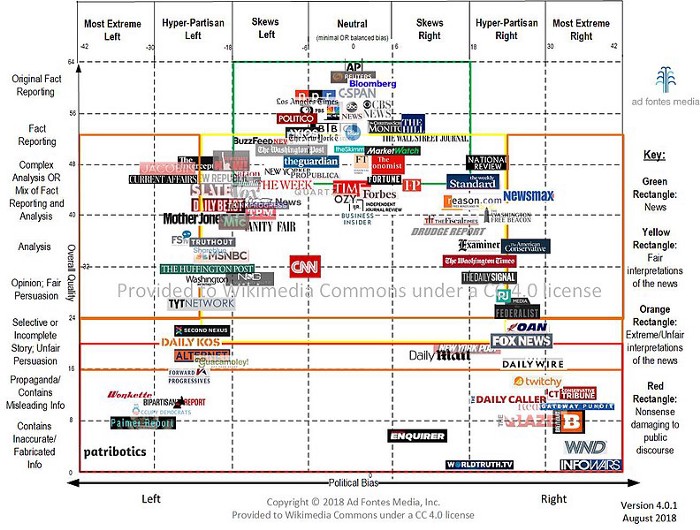
It is reasonable to think some news stories should be considered more important than others. And though one person might have a different ranking than another person, when those subjective rankings are combined across an entire society, the average ranking should reflect the relative importance of news stories within that society.
In reality, however, editors and journalists through their training and position possess disproportionate power in developing those rankings and, subsequently, are the ones who decide what news stories are ‘fit to print’ and make the nightly TV news. Nonetheless, if news organizations — which are mostly for-profit enterprises in the U.S. — want to be economically viable, a common assumption is that they will publish and broadcast the stories most important to the news-consuming public.
The above news-production model, of course, is a middle school civics class load of crap.
American news organizations long ago learned that it is more profitable to create compelling (i.e., commercially attractive) news narratives and to wedge daily events, when possible, into those narratives, not because news organizations aim to deceive the news-consuming public, but because they aim to make money. And, as we’ve all been taught since grade school, it is not a crime in this country to make money.
Politicians, understanding this dynamic, also learned how to exploit those narratives through the timing and targeted content of press conferences, news releases, interviews, and anonymous leaks. In the modern era, there has also been a loose confederation that has formed between senior U.S. government officials and the news media where individuals are allowed (perhaps enticed?) to move freely between them for employment opportunities.
To complete this iron triangle over the forces driving our daily news cycle are corporate lobbyists who, themselves, are often drawn from the news media and government sectors (and vice versa).
No crime is being committed in this process. It requires no conspiracy theory to explain what constitutes news on our nightly newscasts or makes headlines in our daily papers. It is merely the system we have all — passively or actively — accepted as an appropriate mechanism for what determines our news and information.
Joylessly, among the many problems inherent in our mainstream media system, is the fact that non-news — including straight up falsehoods and misinformation— is often commingled with genuine news, making one almost indistinguishable from the other.
This news-production system has been standardized across the news industry, independent of a news organization’s presumed objectivity, be it left-leaning, right-leaning, or “neutral.”
Here is but a recent example of that phenomenon…
Senator Ted Cruz versus New York Governor Andrew Cuomo
I must preface what I’m about to write with this comment: Texas Senator Ted Cruz ditching his constituents during a tragic natural disaster represented “extremely bad optics,” as some of his most ardent supporters have acknowledged. In the context of D.C. politics, it was legitimate news and, in my opinion, speaks volumes about his personal judgment.
[According to prediction markets, Cruz is running in 6th place for the 2024 Republican presidential nomination, behind former President Donald Trump, Florida Governor Ron DeSantis, former South Carolina Governor Nikki Haley, South Dakota Governor Kristi Noem, and former Vice President Mike Pence. IMHO, you can replace Donald Trump’s name with that of his son, Don Jr., who I believe will be the 2024 Republican nominee — but never count out Haley or my dark horse bet, Iowa Senator Joni Ernst.]
But did Cruz’ optic failure deserve being the top news story in the national news media for a good two to three days after the February 13–17 storm hit Texas and other parts of the American Midwest and South?
It is not like there lacked important stories to cover during this period:
(1) The ongoing coronavirus pandemic and the push to roll out the vaccines could have justifiably topped every newscast in February…
(2) … if not for the Democrats’ attempt to impeach and convict Trump for inciting the January 6th riots,
(3) And when the Congress wasn’t obsessing over Trump’s trial, both chambers spent February haggling over whether to provide additional relief to Americans — beyond the $2,000 some received last year — to mitigate the financial stresses caused by the COVID-19 pandemic.
[Compare that to Canada where its citizens have been provided $500 per week for up to 26 weeks in cases where people have stopped working or had their income reduced by at least 50 percent due to COVID-19.]
(4) Also deserving top news consideration in February was a Biden administration announcement on February 5th to reverse a Trump administration decision that put Yemen’s Houthi military forces on our nation’s terrorist organization list,
(5) And then came the devastating mid-February ice storm that paralyzed Texas and killed at least 70 people.
If Figure 1 is any indication, the cable news networks (CNN, MSNBC, and Fox News) did their job fairly well in picking the most prominent stories in February. Trump’s Senate trial dominated cable news airtime in February, particularly on CNN and MSNBC, where each dedicated, on average, around 11 percent of daily airtime to the topic.
[Trump was acquitted by the Senate on February 13th.]
Figure 1: Cable News Airtime Volume for Selected Topics in February 2021
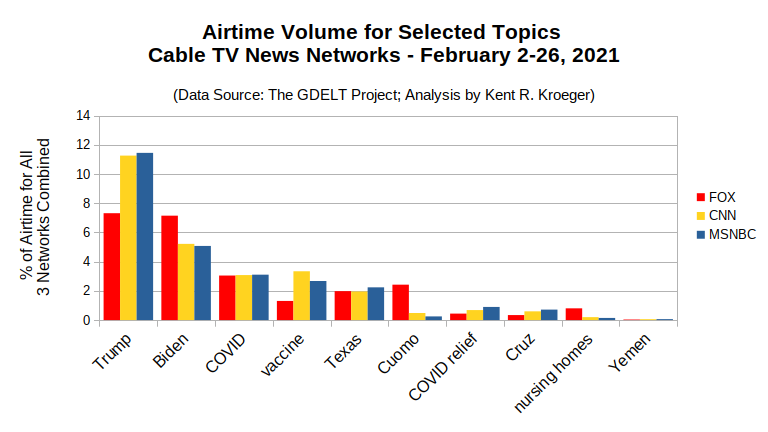
Combined, the three cable networks spent approximately 30 percent of February airtime on the Trump trial, with Fox News contributing just 7 percent to that total. President Joe Biden, likewise, earned a mere 17 percent of cable news airtime for the month.
Whether it was the best use of Congress’ time is debatable, but there is no denying the historical significance of the second Trump impeachment trial. However, by mid-February, the failure of the Senate to convict Trump faded as a story and was replaced by events related to the Texas ice storm (Feb. 13–17) and the ongoing difficulties getting the COVID-19 vaccine administered across the nation.
But it is Cruz’ ill-advised trip to Cancun during the Texas storm — the news of which broke on February 18th — that is most fascinating from a news-bias perspective.
And the Cruz story cannot be understood without reference to another political story that broke on February 11th: An aide to New York Governor Andrew Cuomo, Melissa DeRosa, privately admitted the Cuomo administration delayed the release of data on COVID-19 deaths of long-term care facility residents because of fears of a federal investigation.
A quick summary:
In an understandable effort to relieve stresses on hospitals caused by the COVID-19 outbreak, New York (and other states) decided to move elderly patients hospitalized due to the coronavirus to nursing homes. In the earliest months of this pandemic, that decision was a policy debacle as nursing homes became killing fields for the virus. To this day, New Jersey, New York, Rhode Island, Massachusetts, and Connecticut are still in the Top 10 among U.S. states for the number of COVID-19 deaths per capita. [Will we ever know the names of the “experts” that thought this policy was a good idea? If the objectivity and integrity of our national news media is a factor, don’t count on it.]
If solar sail-traveling aliens from Proxima Centauri had observed and then been asked to judge what story deserved the most media attention in February — Senator Cruz going with his daughters to Cancun during an ice storm versus Governor Cuomo hiding the damage in human lives caused by one of his policies — I can’t imagine an intelligence species that wouldn’t believe the Cuomo story was the most important.
Consider these facts..
At most, hundreds died in Texas due to policy failures almost entirely unrelated to any specific decision made by Senator Cruz, whose policy jurisdiction does not include executive powers in the state of Texas. In the moment, there was little Cruz could do to stave off the impact of the ice storm in Texas, other than making phone calls to energy executives and state bureaucrats and lighting a few fires under their butts, none of whom are accountable to him. But beyond that, there wasn’t much else for him to do.
In contrast, most likely thousands of elderly New Yorkers died because of an ill-considered policy to move elderly COVID patients from hospitals into nursing homes. My statistical estimate for New York puts the policy-related death toll around 9,400. Good intentions considered, the policy was a disaster and there is now evidence New York’s governor tried to minimize his possible accountability for that failure.
So which story do you think the cable news networks covered the most in February?
Combined, all three U.S. cable news networks gave both stories about the same amount of attention (see Figure 2) — 19 percent of daily airtime to the Cuomo story and 16 percent to the Cruz/Cancun story. [The burst of Cruz coverage around February 12th was related to the Trump Senate trial, not his Cancun trip.]
Figure 2: Cable News Daily Airtime on Cruz and Cuomo Stories
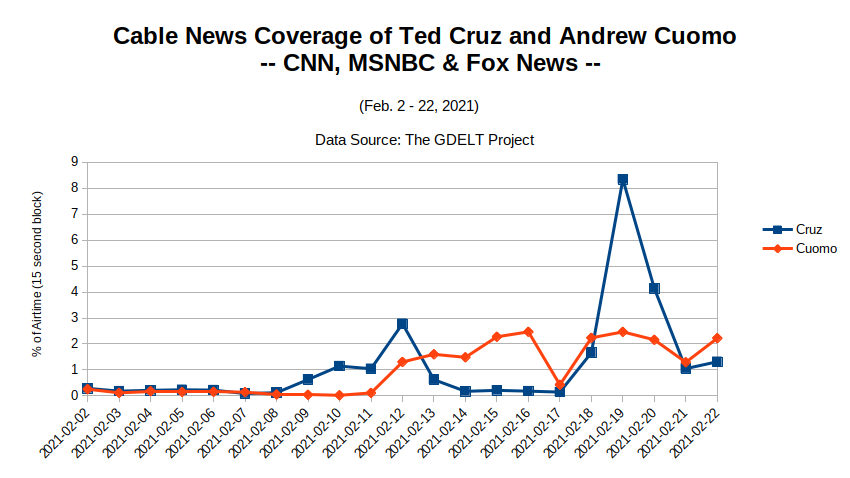
In comparison, online news stories seemed to focus more on Cruz’ Cancun trip than Cuomo’s deadly policy faux pas (see Figure 3). [Is it possible the political bias of high tech is influencing this result? Stop it! What are you? A Capitol-rampaging conspiracy theorist?]
Figure 3: Online News Coverage for Cruz and Cuomo Stories
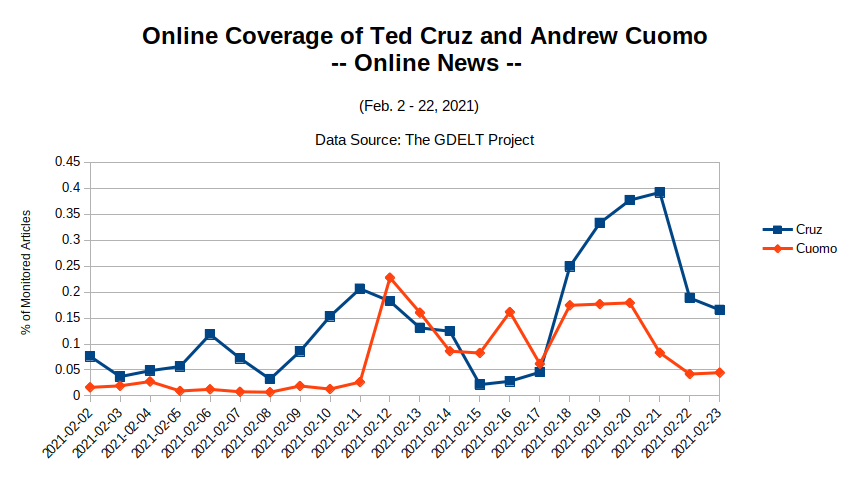
But the most interesting feature of cable news coverage emerges when focusing on CNN and MSNBC’s coverage of the two stories. Their partisan bias is irrefutable. Both networks all but ignored the Cuomo story through February 22nd (and this has continued through February 26th, according to data from The GDELT Project), but as for Cruz’ Father-Daughters trip? A national scandal!
Figure 4: CNN and MSNBC Daily Airtime on Cruz and Cuomo Stories
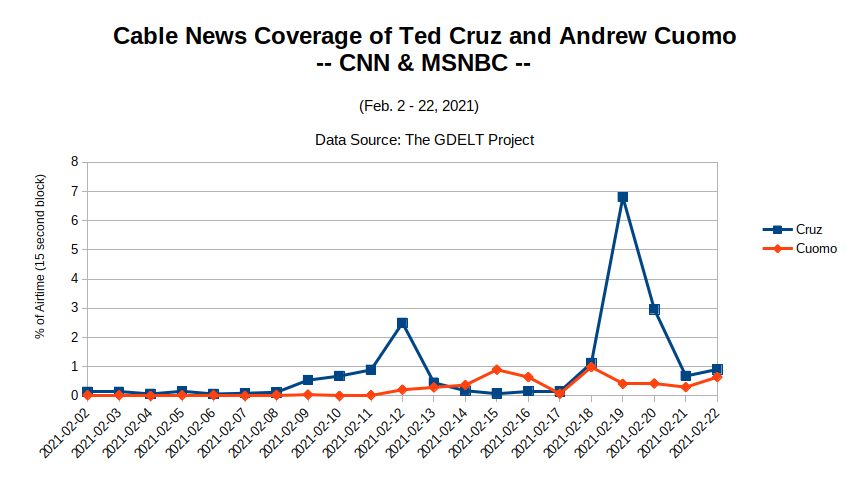
How disconnected from reality must a news organization be to think Cruz’ poorly thought out indiscretion compares to Cuomo’s failure as governor to protect his state’s most vulnerable citizens?
Final Thoughts
Perhaps it is a mistake to consider the cable news networks separately. Maybe the Republican-bias inherent in Fox News coverage serves as a necessary balance to the other major cable news networks?
I would be happy with that fact if it weren’t clear from audience data that most people watching CNN or MSNBC are not also watching Fox News (and vice versa). In my opinion, if people are not honestly and consistently exposed to multiple points of view, how can they possibly develop independent opinions of their own?
But could that independent information function be provided by “neutral” news sources, as implied to exist according to this essay’s headline graphic (developed by Ad Fontes Media founder Vanessa Ortero)? Could the Bloomberg, AP and Reuters news services be that critical component to building a well-informed public?
Unfortunately, my preliminary analysis of AP, Reuters and Bloomberg content suggests they aren’t that much different from CNN and MSNBC in their story selection.
If I were doing the labeling for Otero’s media bias graphic, the label “neutral” would be replaced by the word “status quo.”
Our profit-motivated mainstream media does little more than trump up (pardon the pun) superficial controversies that do nothing to challenge the status quo.
Hence, the phony Cruz/Cancun outrage.
In the process, the American people — apart from the political and economic elite who benefit from a hopelessly divided populace — are getting screwed.
- K.R.K.
Send comments to: nuqum@protonmail.com
An inferior U.S. health care system made the COVID-19 pandemic worse
By Kent R. Kroeger (Source: NuQum.com; February 19, 2021)
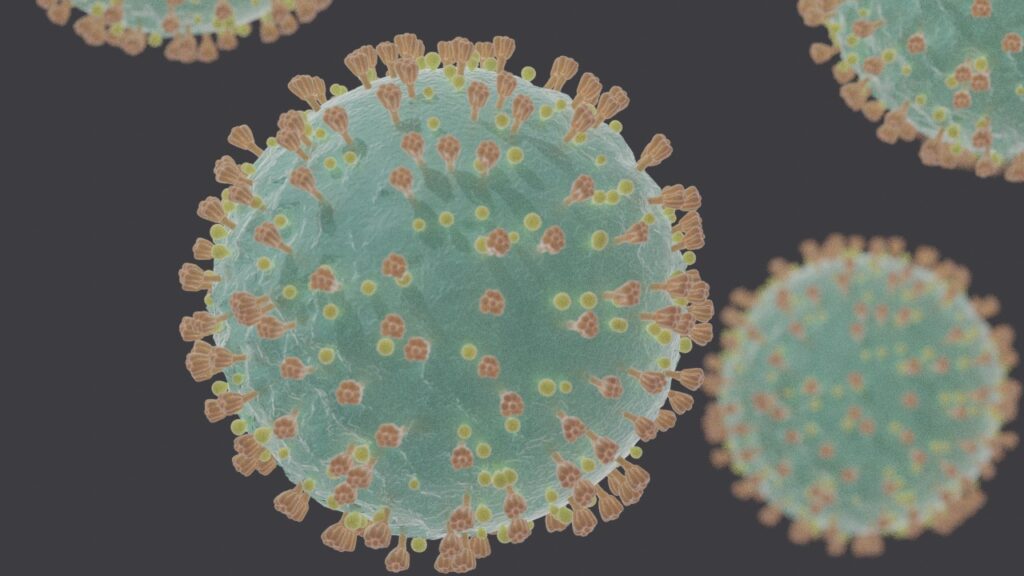
The U.S. may have experienced 7.7 million additional COVID-19 cases and 155 thousand additional COVID-19 deaths due to its subpar health care system.
This finding is based on a cross-national statistical analysis of 20 West European and West European-heritage countries using aggregate, country-level data provided by Johns Hopkins University (COVID-19 cases and deaths per 1 million people), OurWorldInData.org (Policy Stringency Index) and HealthSystemFacts.org (Health Access and Quality Index). The analysis covers the period from January 1, 2020 to February 5, 2021.
Figure 1 (below) shows the bivariate relationship between the number of COVID-19 cases (per 1 million people) and the quality of a country’s health care system as measured by the Health care Access and Quality Index (HAQ Index ) that was compiled during the 2016 Global Burden of Disease Study.
In countries where health care access is universal and of high quality, the performance on the number of COVID-19 cases per capita is much better. New Zealand, Australia, Iceland, Finland and Norway are positive exemplars in this regard. Israel, Portugal, U.S., and the U.K., in comparison, are not.
Figure 1: Health care access/quality (HAQ) and its relationship to COVID-19 cases per 1 million people
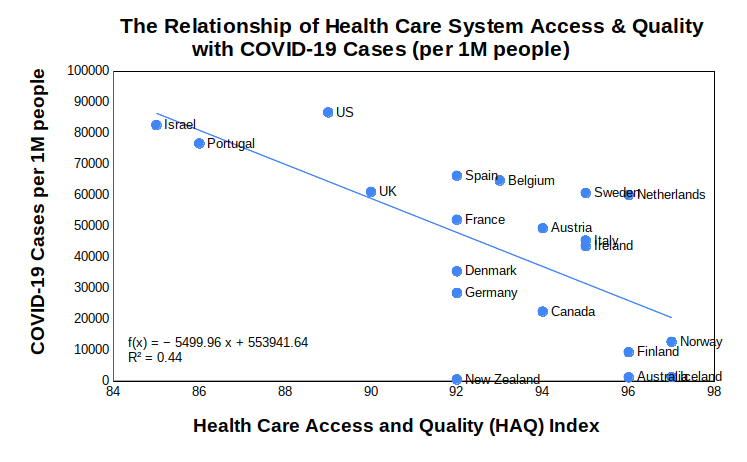
More interestingly, if over the study period we control for the average level of COVID-19 policy actions (as measured by Oxford University’s COVID-19 Government Response Tracker (OxCGRT)) and whether or not a country is an island, the significance of the quality of a country’s health care system remains significant.
As seen in this simple linear regression model, three variables — the HAQ Index, COVID-19 Policy Stringency, and whether or not the country is an island — account for about 60 percent of the variance in COVID-19 cases per capita for these 20 countries.

Using this model, we can estimate the number of COVID-19 cases (per 1 million people) the U.S. would have experienced if its health care system was as good as the countries rated as having the best health care systems in the world (Iceland and Norway — HAQ Index = 97).
(-2946.23 * 8)*330 = 7,778,000 additional COVID-19 cases
[Note: U.S. has approximately 330 million people and its HAQ Index = 89]
Additionally, as there is a strong relationship between the number of COVID-19 cases per capita and the number of COVID-19 deaths per capita (i.e., roughly 0.2 deaths per case — see Appendix), we can estimate that the U.S. has experienced 155,560 additional deaths as a result of inadequacies with its health care system.
The U.S. does not have the best health care system in the world
Remarkably little discussion within the national news media has been about the systemic problems within the U.S. health care system and how those problems contributed to the tragic COVID-19 numbers witnessed by this country during the pandemic. Where most of the media attention has been focused on political failures associated with the COVID-19 pandemic — and most of that has been directed at the Trump administration — the hard evidence continues to suggest systemic factors, such as racial disparities in socioeconomics and health, are driving U.S. COVID-19 case and death rates above other developed countries.
“Socioeconomically and racially segregated neighborhoods are more vulnerable and are more likely to be disproportionately impacted by the adverse effects of COVID-19,” conclude health analysts Ahmad Khanijahani and Larisa Tomassoni. As for why this is the case, Khanijahani and Tomassoni offer this explanation:
“Black and low-SES individuals in the US are more likely to be employed as essential workers in occupations such as food distribution, truckers, and janitors. Most of these jobs cannot be fulfilled remotely and usually do not offer adequate sick leaves. Additionally, individuals of low-SES and Black minority are disproportionately impacted by homelessness or reside in housing units with limited space that makes the practice of isolating infected family members challenging or impossible. Moreover, limited or no child/elderly care and higher uninsurance rates impose an additional financial burden on low-SES families (emphasis mine) making it challenging to stop working.”
The racial and ethnic disparities in COVID-19 death figures (in Figure 2) are shockingly apparent in the following graphic produced by the The Centers for Disease Control and Prevention (CDC).
Figure 2: Racial/ethnic disparities in COVID-19 deaths in the U.S. (Source: CDC)
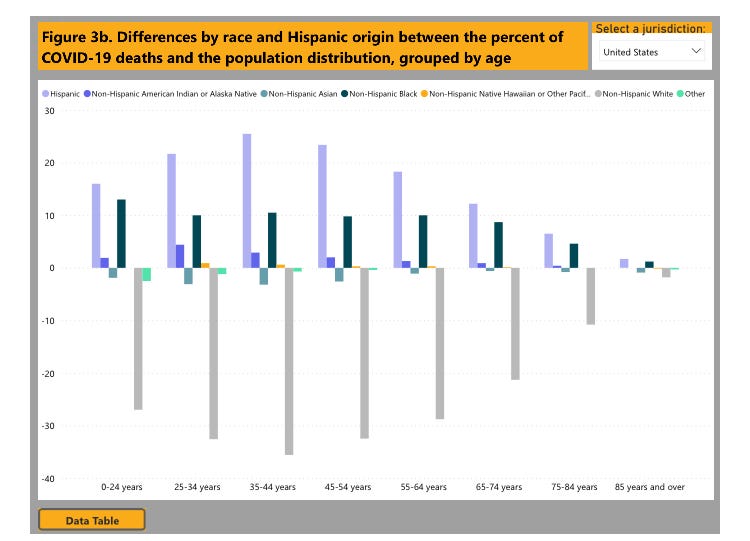
The gray bars in Figure 2 show how non-Hispanic Whites across all age categories have experienced fewer deaths than expected relative to their prevalence in the total U.S. population. In stark contrast, across all age groups, Hispanic and non-Hispanic Blacks account for a significantly higher percentage of COVID-19 deaths than expected based on their population numbers.
Figure 2 is what a broken health care system interacting with systemic racial and ethnic inequalities looks like in a chart.
Final thoughts
Citing the negative role of the U.S. health care system on COVID-19 outcomes is not an indictment of U.S. health care workers. To the contrary, because Americans live in a country where health care is significantly rationed by market forces — e.g., a relatively high rate of uninsured, people delaying preventative care, diagnoses and treatments due to financial concerns, etc. — our health care workers are forced to work harder as a high number of COVID-19 patients enter the health care system only after their symptoms have already become severe.
The awful impact of the COVID-19 pandemic on Americans is less a political failure than it is a systemic failure —though we cannot dismiss the ineptitude of politicians like New York Governor Andrew Cuomo who, presumably at the behest of his health policy experts, authorized sending critically ill seniors from hospitals to nursing homes in order to free up hospital beds. New York’s elderly paid a steep price so Governor Cuomo could learn that nursing homes are not hospitals.
More broadly, the COVID-19 pandemic exposed a broken and inadequate U.S. health care system that is better designed to protect high profit margins for insurance and pharmaceutical companies and the billing rates of physicians than it is to ensure the health of the American people.
Sadly, with the physician, health insurance and pharmaceutical lobbyists firmly entrenched in the policymaking machinery of the Biden administration, don’t expect any time soon the types of health care system reforms needed to fix our systemic problems.
- K.R.K.
Send comments to: nuqum@protonmail.com
Methodological Note:
The decision to analyze just 20 West European and West European-heritage countries (i.e., U.S., Israel, Canada, Australia, and New Zealand) was prompted by a desire to control for two factors that are significantly related to country-level COVID-19 outcomes: (1) cultural norms, and (2) economic development.
Controlling for cultural norms, particularly the differences between countries with individualistic cultures (i.e., Western European nations) and those with collectivist cultures (i.e., East Asian nations), facilitated a clearer look at the impact health care systems on COVID-19 outcomes.
As for the exclusion of lesser-developed countries from this analysis, I simply don’t trust the accuracy or completeness of their COVID-19 data.
APPENDIX — A Linear Model of COVID-19 Deaths (Per 1 Million People)
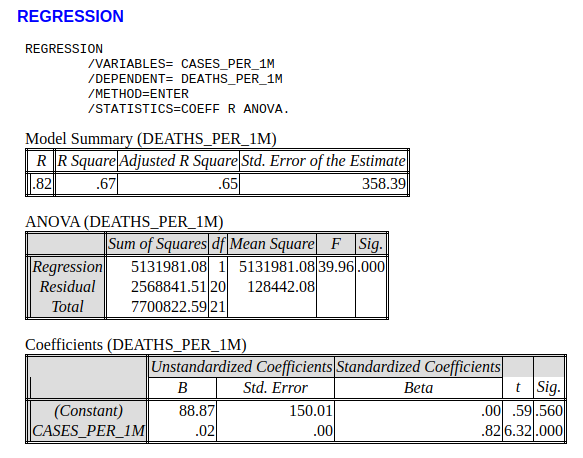
Were proactive COVID-19 policies the key to success?
By Kent R. Kroeger (Source: NuQum.com; February 11, 2021)
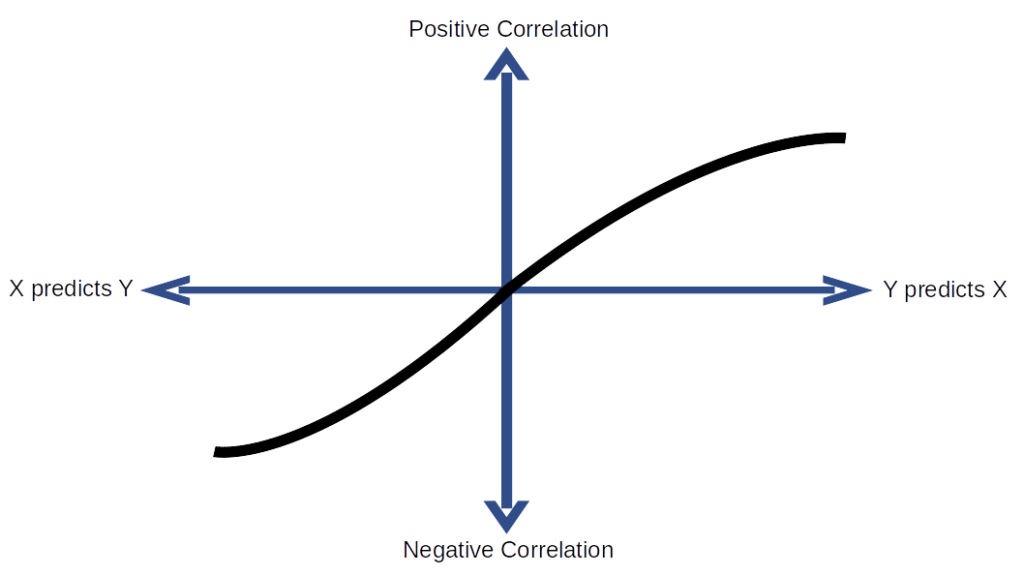
There is no weenier way of copping out in data journalism (and social science more broadly) than posing a question in an article’s headline.
This intellectual timidity probably stems from the fact that most peer-reviewed, published social science research findings are irreproducible. In other words, social science research findings are more likely a function of bias and methodology than a function of reality itself.
As my father, a mechanical engineer, would often say: “Social science is not science.”
The consequence is that social science findings are too often artifacts of their methods and temporal context — so much so that a field like psychology has become a graveyard for old, discredited theories: Physiognomy (i.e., assessing personality traits through facial characteristics), graphology (i.e., assessing personality traits through handwriting), primal therapy (i.e., psychotherapy method where patients re-experience childhood pains), and neuro-linguistic programming (i.e., reprogramming behavioral patterns through language) are just a few embarrassing examples.
Indeed, established psychological theories such as cognitive dissonancehave proven to be such an over-simplification of behavioral reality that their practical and academic utility is debatable.
And what does this have to do with COVID-19? Not much. I’m just venting.
Well, not exactly.
The COVID-19 pandemic has unleashed a torrent of speculation and research about what COVID-19 policies work and don’t work.
For example, how effective are masks and mandatory mask policies?
Masks work, conclude most studies.
Another cross-national study, however, found that it is cultural norms that drive the effectiveness of mandatory mask policies.
And there are credible scientific studies that show the effectiveness of masks can be seriously compromised without other factors in place (namely, social distancing).
In part, the variation in findings on mask-wearing is a product of a healthy application of the scientific method. No single study can address every aspect of mask effectiveness.
Research is like a gestalt painting where a single study represents but a tiny part of the total picture. One must step back from the specific research findings of one study in order to understand the essence of all the research together.
In other words, masks work, but with some important caveats.
Some countries have done a better job than others at containing COVID-19
Among the largest, most developed economies, it is increasingly apparent which countries have been most effective at minimizing the impact of COVID-19.
According to the cumulative tally reported at RealClearPolitics.com, these 10 developed countries have the lowest COVID-19 deaths rates (per 1 million people) as of February 10, 2021:
Taiwan — 0 (deaths per 1 million)
China — 3
Singapore — 5
New Zealand — 5
Iceland — 6
South Korea — 29
Australia — 36
Japan — 52
UAE — 99
Norway — 111
On the other end of the scale, these 10 developed countries have the highest COVID-19 deaths rates (per 1 million people) as of February 10, 2021:
Belgium — 1,880 (deaths per 1 million)
UK — 1,712
Italy — 1,522
U.S. — 1,467
Portugal — 1,431
Spain — 1,350
Mexico — 1,335
Sweden — 1,210
France — 1,196
Switzerland — 1,139
If there are complaints about the validity of the data from China or Taiwan, I am all ears. However, regardless of their inclusion, an informal review of the other advanced countries suggests some patterns in their COVID-19 outcomes over time.
First, in fighting COVID-19, it helps to be on an island (Taiwan, Singapore, New Zealand, Iceland, Australia, and Japan). And for all practical purposes, I consider South Korea to have near-island status as few people enter that country by way of a land border.
Second, it appears European romance language countries such as Italy, Portugal, Spain, France (tourism perhaps?) and countries with subpar health care systems (such as the U.S. and Switzerland which rely disproportionately on insurance-based health care access) have not fared well in fighting COVID-19.
On an anecdotal level, at least, I’ve explained most of the high- and low-performing countries with respect to COVID-19 without even referencing their COVID-19 policies.
So what impact have COVID-19 policies had on containing this pandemic?
Though lacking a definitive answer that question on a specific policy level, in the aggregate, there are strong indications that changes in national COVID-19 policies have had, for a small subset of countries, at least one of two discernible relationships with weekly variation in new COVID-19 cases: A small number of countries have been proactive in their COVID-19 policies and the result has been relatively few COVID-19 deaths per capita. Another small set of countries have been reactive in their COVID-19 policies and their COVID-19 deaths per capita have been relatively higher in comparison to the proactive countries. As for most countries, they fall somewhere in the middle, as they are both proactive and reactive.
Before we look at the data, here is a conceptual perspective.
Figure 1 visualizes a theoretical framework for how national policies may relate to the spread of COVID-19 (see Figure 1). There are two axes: (1) The vertical axis represents the correlation between changes in COVID-19 policies and changes in weekly new cases of COVID-19, while the (2) second axis represents that relationship at various time lags.
In this construct, consider the weekly number of new COVID-19 cases to be our outcome variable (Y) and the stringency of national COVID-19 policies to be our input variable (X).
The intersection of the two axes represents the contemporaneous relationship between COVID-19 policies (X) and new COVID-19 cases (Y). As one proceeds to the left of center on the vertical axis, this represents the relationship between prior values of COVID-19 policy with future numbers of new COVID-19 cases (i.e., X causes Y). As one proceeds to the right of center on the vertical axis, this represents the relationship between prior numbers of new COVID-19 cases with future values of COVID-19 policy (Y causes X).
Figure 1: A Theoretical Framework for Understanding COVID-19 Policies

Figure 2 shows the practical implication of Figure 1: COVID-19 policies in some countries will generally follow the red line over time (reactive), while others the green line (proactive), and still others — probably the majority of countries — will follow the black line (a combination of reactive and proactive policy changes).
Figure 2: Proactive Policies versus Reactive Policies
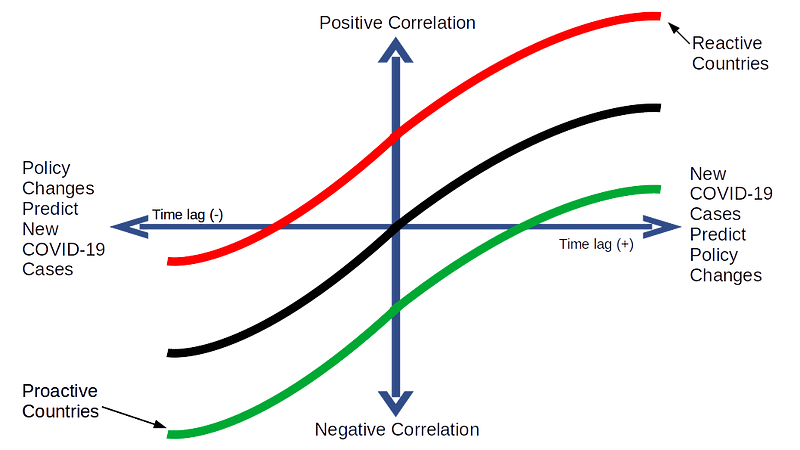
In fact, these patterns did emerge across the 30 countries I analyzed when I plotted the cross correlations over time between changes in their COVID-19 policies and changes in the weekly number of new COVID-19 cases.
Country-level patterns in COVID-19 policy effectiveness
As demonstrably important as COVID-19 policies such as mask mandates or business lockdowns are to containing COVID-19, my curiosity is with an aggregate measure of those policies, as any single policy will not be enough to address something as pervasive as COVID-19.
As a result, I used country-level COVID-19 policy data from the Coronavirus Government Response Tracker (OxCGRT) compiled by researchers at the Blavatnik School of Government at the University of Oxford who aggregate 17 policy measures, ranging from containment and closure policies (such as such as school closures and restrictions in movement); economic policies; and health system policies (such as testing regimes), to create one summary measure: The COVID-19 Policy Stringency Index (PSI). Details on how OxCGRT collects and summarizes their policy data can be found in a working paper.
The outcome measure used here is the number of new COVID-19 cases reported by Johns Hopkins University every week from January 20, 2020 to February 5, 2021 for each of the following countries: Australia, Austria, Belgium, Brazil, Canada, Denmark, Finland, France, Germany, Greece, Iceland, India, Indonesia, Ireland, Israel, Italy, Japan, Mexico, Netherlands, New Zealand, Norway, Portugal, Russia, South Africa, South Korea, Spain, Sweden, Switzerland, UK, and US.
It should be noted that the raw data from OxCGRT and Johns Hopkins were at the daily level, but was aggregated to the weekly level for data smoothing purposes.
In total, there were 50 data points for each of the 30 countries, and to address the relevance of the theoretical framework in Figure 2 a bivariate Granger causality test is employed for each country (an example of the R code used to generate this analysis is in the appendix).
The Results
Of the 30 countries in this analysis, bivariate Granger causality tests found only three in which prior increases in the stringency of COVID-19 policies (PSI) were significantly associated with decreases in the weekly numbers of new COVID-19 cases (Iceland, New Zealand, and Norway). Figures 3 through 5 show the cross correlation functions (CCF) for those countries in which their COVID-19 policies shaped events, instead of merely reacting to them. Hence, I label their COVID-19 policies as proactive.
In another six countries it was found that increases in the stringency of COVID-19 policies tended to follow increases in the weekly numbers of new COVID-19 cases (see Figures 6 through 9). In other words, their COVID-19 policies tended to follow events instead of shaping them. The policies in these countries are therefore labeled as reactive.
For the remaining 21 countries, the Granger causality tests revealed no significant relationships in either causal direction, though their CCF patterns tended to follow the S-curve shape posited in Figures 1 and 2. The lack of statistical significance in those cases could be a function of the limited samples sizes which was a product of aggregating the data to the weekly-level.
PROACTIVE COUNTRIES:
Figure 3: Cross Correlation Function — Iceland

Figure 4: Cross Correlation Function — New Zealand

Figure 5: Cross Correlation Function — Norway

REACTIVE COUNTRIES:
Figure 6: Cross Correlation Function — Germany

Figure 7: Cross Correlation Function — Israel

Figure 8: Cross Correlation Function — Switzerland

Figure 9: Cross Correlation Function — Austria

Proactive countries have had better COVID-19 outcomes
Figure 10 and 11 reveal how the COVID-19 outcomes in the proactive countries were significantly better than in the other countries. Countries that kept ahead of the health crisis did a better job of controlling the health crisis.
Figure 10: Confirmed COVID-19 Cases (per 1 million) by Policy Group

Figure 11: Confirmed COVID-19 Deaths (per 1 million) by Policy Group
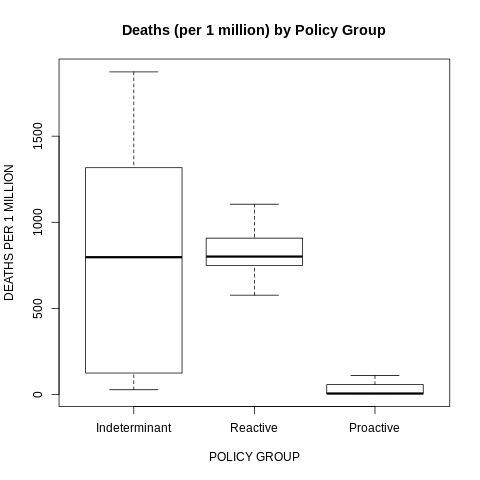
Not coincidentally, many of the qualitative and quantitative analyses of worldwide COVID-19 policies have found Iceland, New Zealand, and Norway among the highest performers according to their metrics (examples are here, here and here).
Final Thoughts
In no way does my analysis suggest that COVID-19 policies in only three countries (Iceland, New Zealand, and Norway) were effective and the policies in the remaining countries were mere reactions to an ongoing health crisis they could not control.
Undoubtedly, there are well-documented examples of policy impotence across this worldwide pandemic. The lack of a consistent mask mandates in U.S. states like Arizona, North Dakota and South Dakota may help explain why those states have among the highest COVID-19 infection rates in the country. Sweden’s initial decision to keep their economy open during the early stages of the pandemic most likely explains their relatively high case and fatality rates relative to their Scandinavian neighbors.
But, in fairness, not every policy (or lack thereof) is going to work for a pathogen that has proven to be so pernicious. At the same time, as this pandemic winds down with the roll out of vaccinations, we are now seeing evidence in retrospect that a relatively small number of countries did do a better job than others in managing this pandemic. For the majority of countries, however, their policy leaders may have had frighteningly little impact on the ultimate course of this virus. Their citizens would have been better off moving to an island.
- K.R.K.
Send comments to: nuqum@protonmail.com
Appendix
R code used to generate the bivariate Granger causality test for Iceland:
y <- c(49.00,106.00,317.00,490.00,454.00,272.00,71.00,30.00,8.00,3.00,1.00,2.00,2.00,.00,2.00,7.00,5.00,10.00,3.00,5.00,5.00,50.00,62.00,44.00,59.00,42.00,36.00,26.00,145.00,294.00,271.00,588.00,538.00,396.00,471.00,198.00,123.00,83.00,102.00,105.00,76.00,69.00,62.00,71.00,126.00,76.00,25.00,21.00)
x <- c(16.67,16.67,48.02,53.70,53.70,53.70,53.70,53.70,53.70,50.53,50.00,50.00,41.27,39.81,39.81,39.81,39.81,39.81,39.81,39.81,39.81,41.66,46.30,46.30,46.30,46.30,46.30,39.15,37.96,37.96,37.96,40.34,39.15,42.99,46.43,52.78,52.78,52.78,52.78,52.78,52.78,52.78,52.78,52.78,50.40,46.82,44.44,44.44)
par8 = '4'
par7 = '0'
par6 = '1'
par5 = '1'
par4 = '1'
par3 = '0'
par2 = '1'
par1 = '1'
ylab = 'y'
xlab = 'x'
par8 <- '4'
par7 <- '0'
par6 <- '1'
par5 <- '1'
par4 <- '1'
par3 <- '0'
par2 <- '1'
par1 <- '1'
library(lmtest)
par1 <- as.numeric(par1)
par2 <- as.numeric(par2)
par3 <- as.numeric(par3)
par4 <- as.numeric(par4)
par5 <- as.numeric(par5)
par6 <- as.numeric(par6)
par7 <- as.numeric(par7)
par8 <- as.numeric(par8)
ox <- x
oy <- y
if (par1 == 0) {
x <- log(x)
} else {
x <- (x ^ par1 - 1) / par1
}
if (par5 == 0) {
y <- log(y)
} else {
y <- (y ^ par5 - 1) / par5
}
if (par2 > 0) x <- diff(x,lag=1,difference=par2)
if (par6 > 0) y <- diff(y,lag=1,difference=par6)
if (par3 > 0) x <- diff(x,lag=par4,difference=par3)
if (par7 > 0) y <- diff(y,lag=par4,difference=par7)
print(x)
print(y)
(gyx <- grangertest(y ~ x, order=par8))
(gxy <- grangertest(x ~ y, order=par8))
postscript(file="/home/tmp/1auwb1612990002.ps",horizontal=F,onefile=F,pagecentre=F,paper="special",width=8.3333333333333,height=5.5555555555556)
op <- par(mfrow=c(2,1))
(r <- ccf(ox,oy,main='Cross Correlation Function (raw data)',ylab='CCF',xlab='Lag (k)'))
(r <- ccf(x,y,main='Cross Correlation Function (transformed and differenced)',ylab='CCF',xlab='Lag (k)'))
par(op)
dev.off()
postscript(file="/home/tmp/2xjfo1612990002.ps",horizontal=F,onefile=F,pagecentre=F,paper="special",width=8.3333333333333,height=5.5555555555556)
op <- par(mfrow=c(2,1))
acf(ox,lag.max=round(length(x)/2),main='ACF of x (raw)')
acf(x,lag.max=round(length(x)/2),main='ACF of x (transformed and differenced)')
par(op)
dev.off()
postscript(file="/home/tmp/3zoqj1612990002.ps",horizontal=F,onefile=F,pagecentre=F,paper="special",width=8.3333333333333,height=5.5555555555556)
op <- par(mfrow=c(2,1))
acf(oy,lag.max=round(length(y)/2),main='ACF of y (raw)')
acf(y,lag.max=round(length(y)/2),main='ACF of y (transformed and differenced)')
par(op)
dev.off()
a<-table.start()
a<-table.row.start(a)
a<-table.element(a,'Granger Causality Test: Y = f(X)',5,TRUE)
a<-table.row.end(a)
a<-table.row.start(a)
a<-table.element(a,'Model',header=TRUE)
a<-table.element(a,'Res.DF',header=TRUE)
a<-table.element(a,'Diff. DF',header=TRUE)
a<-table.element(a,'F',header=TRUE)
a<-table.element(a,'p-value',header=TRUE)
a<-table.row.end(a)
a<-table.row.start(a)
a<-table.element(a,'Complete model',header=TRUE)
a<-table.element(a,gyx$Res.Df[1])
a<-table.element(a,'')
a<-table.element(a,'')
a<-table.element(a,'')
a<-table.row.end(a)
a<-table.row.start(a)
a<-table.element(a,'Reduced model',header=TRUE)
a<-table.element(a,gyx$Res.Df[2])
a<-table.element(a,gyx$Df[2])
a<-table.element(a,gyx$F[2])
a<-table.element(a,gyx$Pr[2])
a<-table.row.end(a)
a<-table.end(a)
table.save(a,file="/home/tmp/4l57f1612990002.tab")
a<-table.start()
a<-table.row.start(a)
a<-table.element(a,'Granger Causality Test: X = f(Y)',5,TRUE)
a<-table.row.end(a)
a<-table.row.start(a)
a<-table.element(a,'Model',header=TRUE)
a<-table.element(a,'Res.DF',header=TRUE)
a<-table.element(a,'Diff. DF',header=TRUE)
a<-table.element(a,'F',header=TRUE)
a<-table.element(a,'p-value',header=TRUE)
a<-table.row.end(a)
a<-table.row.start(a)
a<-table.element(a,'Complete model',header=TRUE)
a<-table.element(a,gxy$Res.Df[1])
a<-table.element(a,'')
a<-table.element(a,'')
a<-table.element(a,'')
a<-table.row.end(a)
a<-table.row.start(a)
a<-table.element(a,'Reduced model',header=TRUE)
a<-table.element(a,gxy$Res.Df[2])
a<-table.element(a,gxy$Df[2])
a<-table.element(a,gxy$F[2])
a<-table.element(a,gxy$Pr[2])
a<-table.row.end(a)
a<-table.end(a)
table.save(a,file="/home/tmp/5drvm1612990002.tab")
try(system("convert /home/tmp/1auwb1612990002.ps /home/tmp/1auwb1612990002.png",intern=TRUE))
try(system("convert /home/tmp/2xjfo1612990002.ps /home/tmp/2xjfo1612990002.png",intern=TRUE))
try(system("convert /home/tmp/3zoqj1612990002.ps /home/tmp/3zoqj1612990002.png",intern=TRUE))